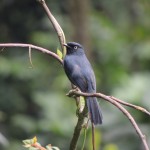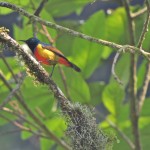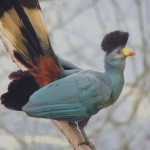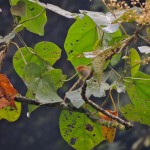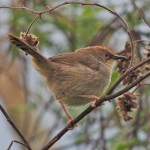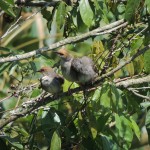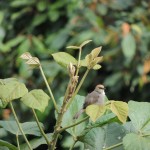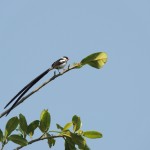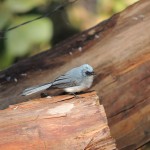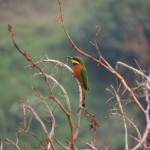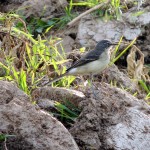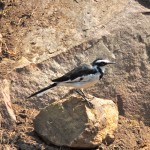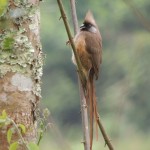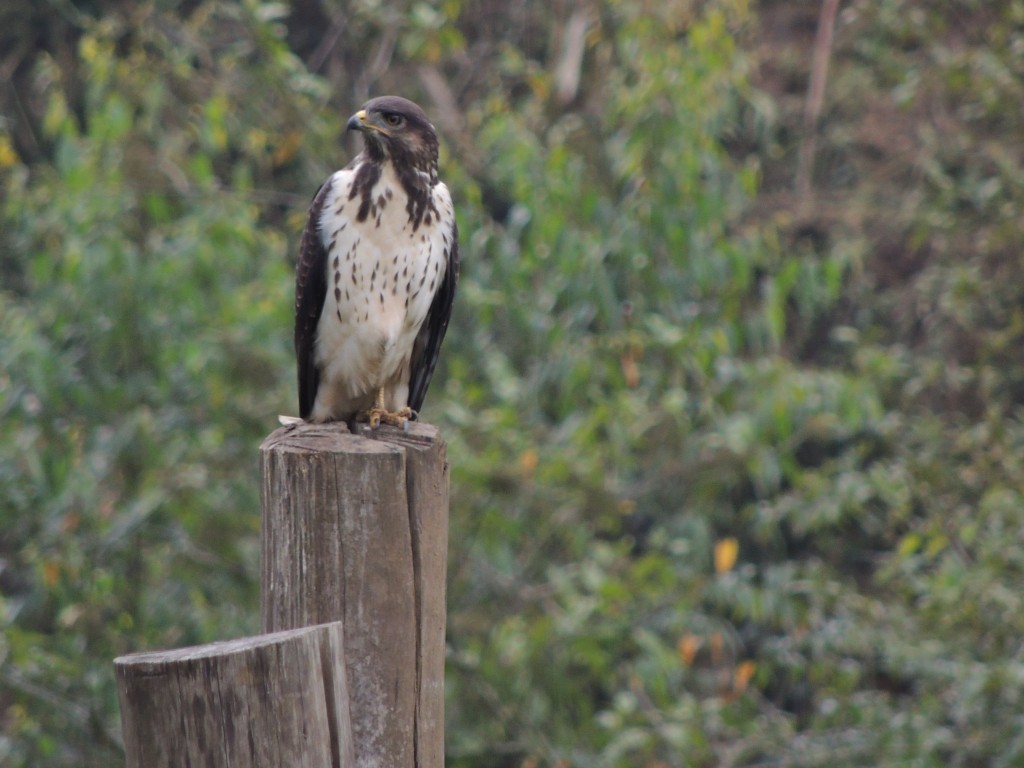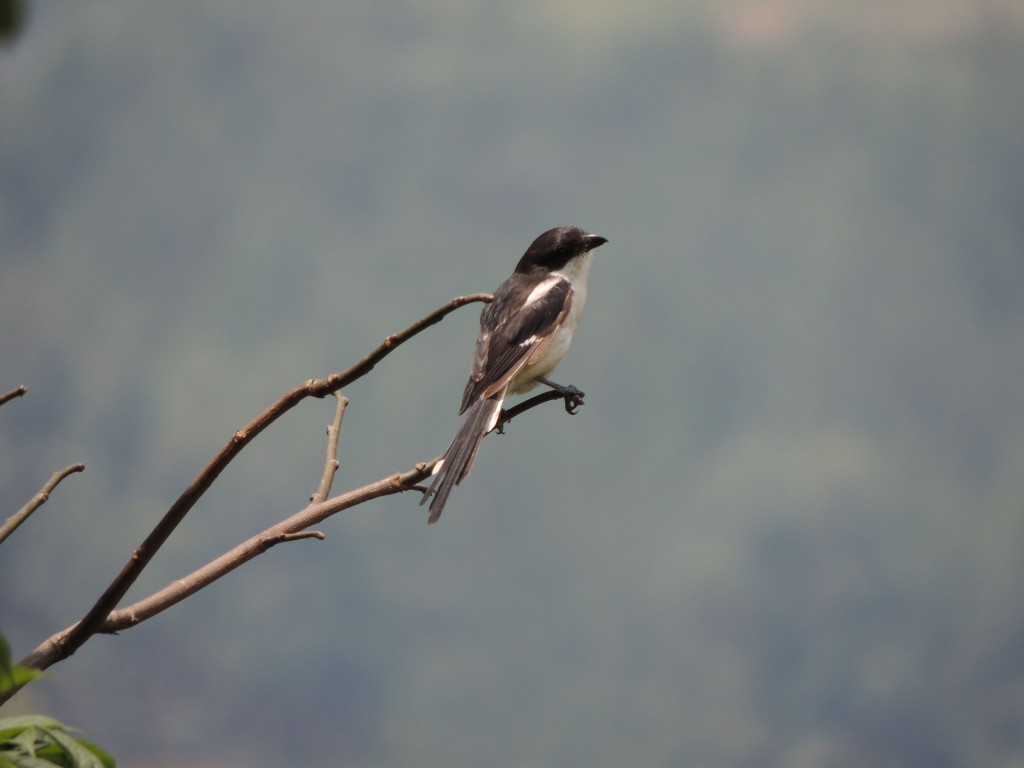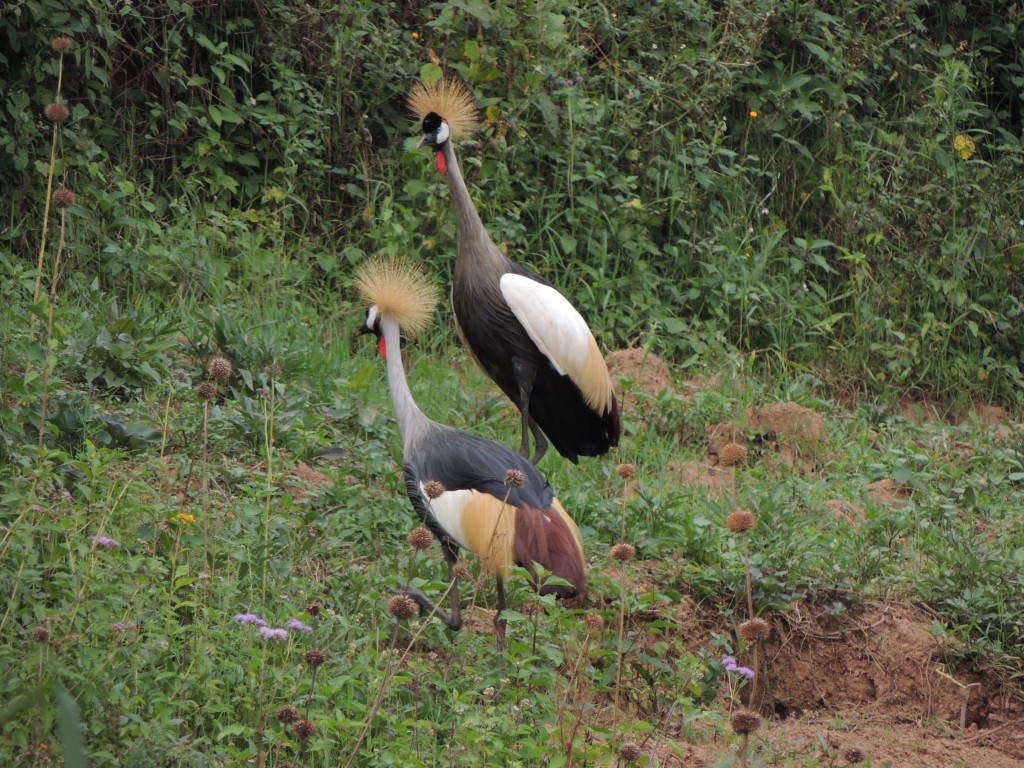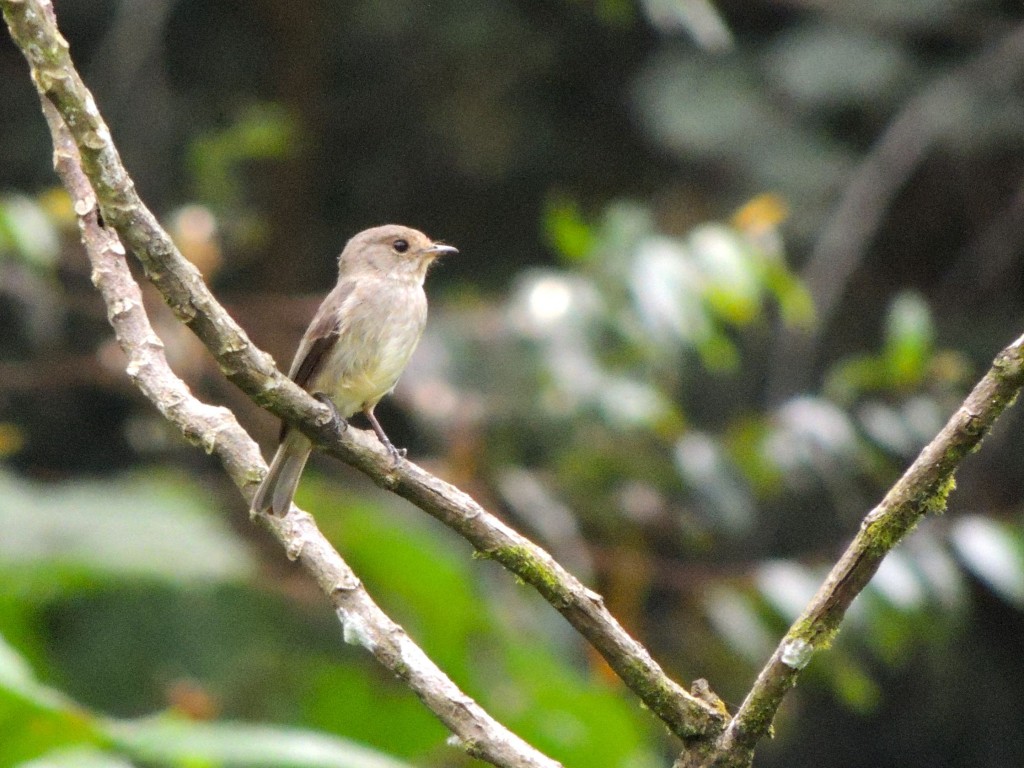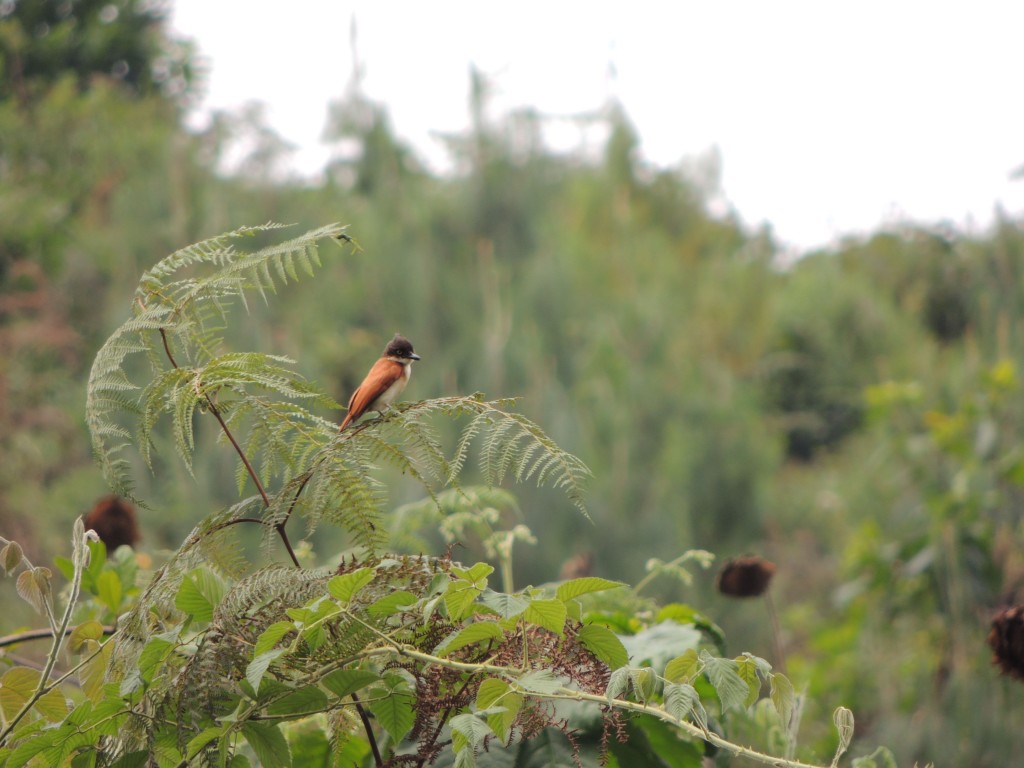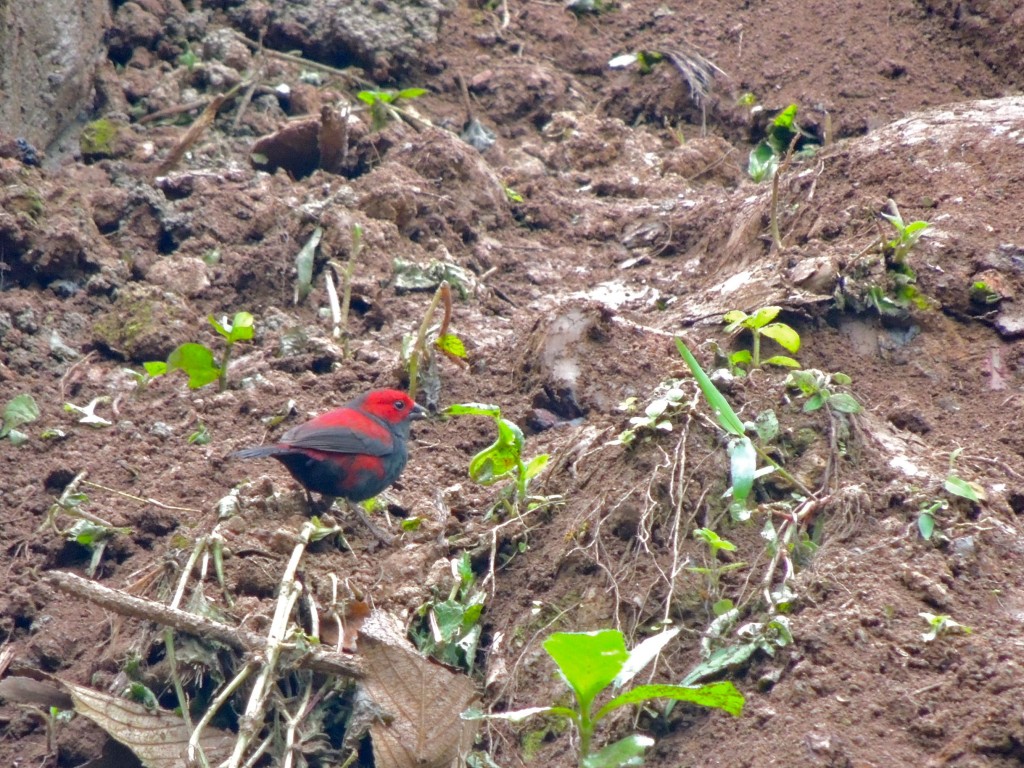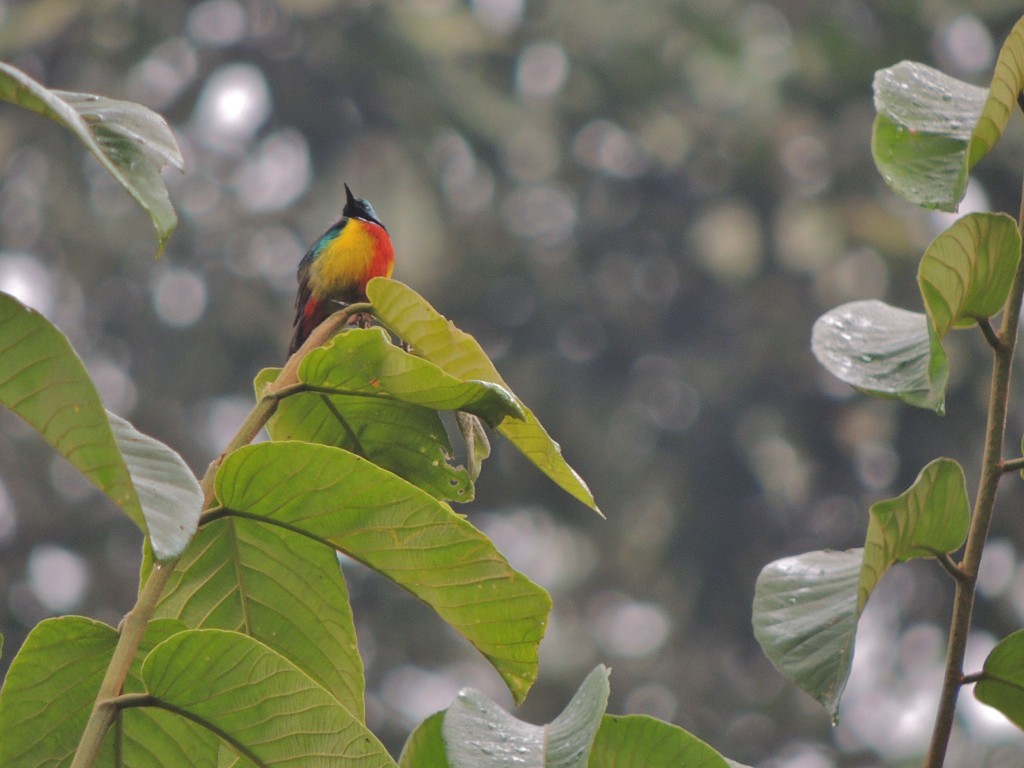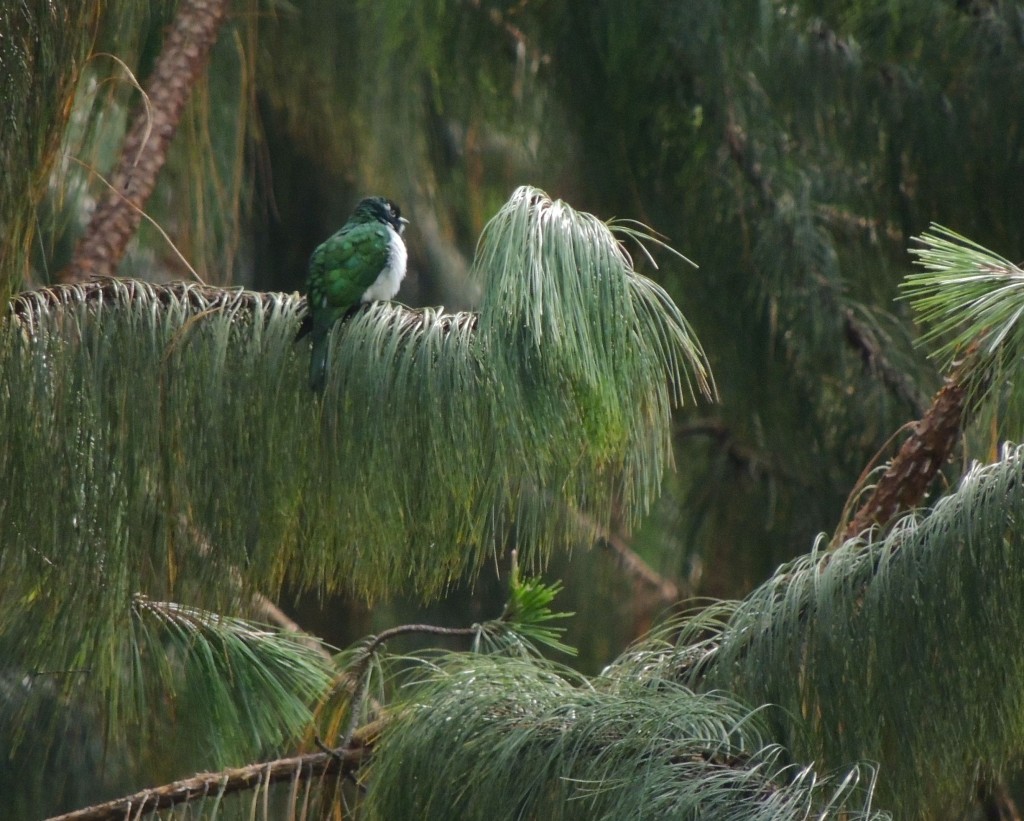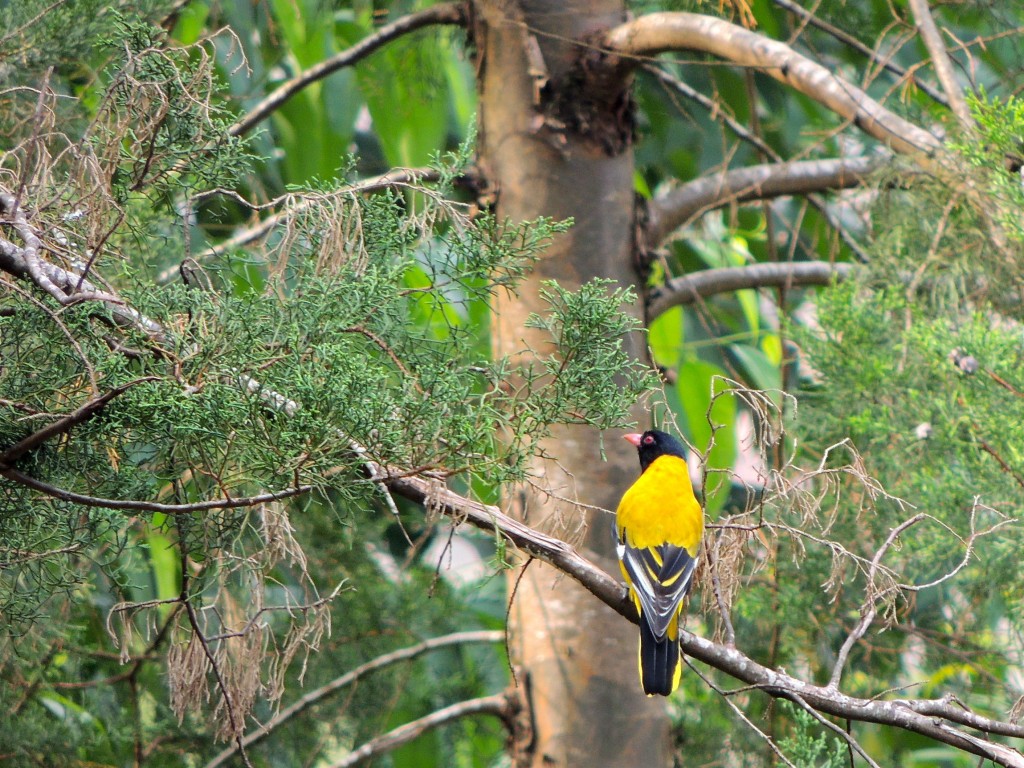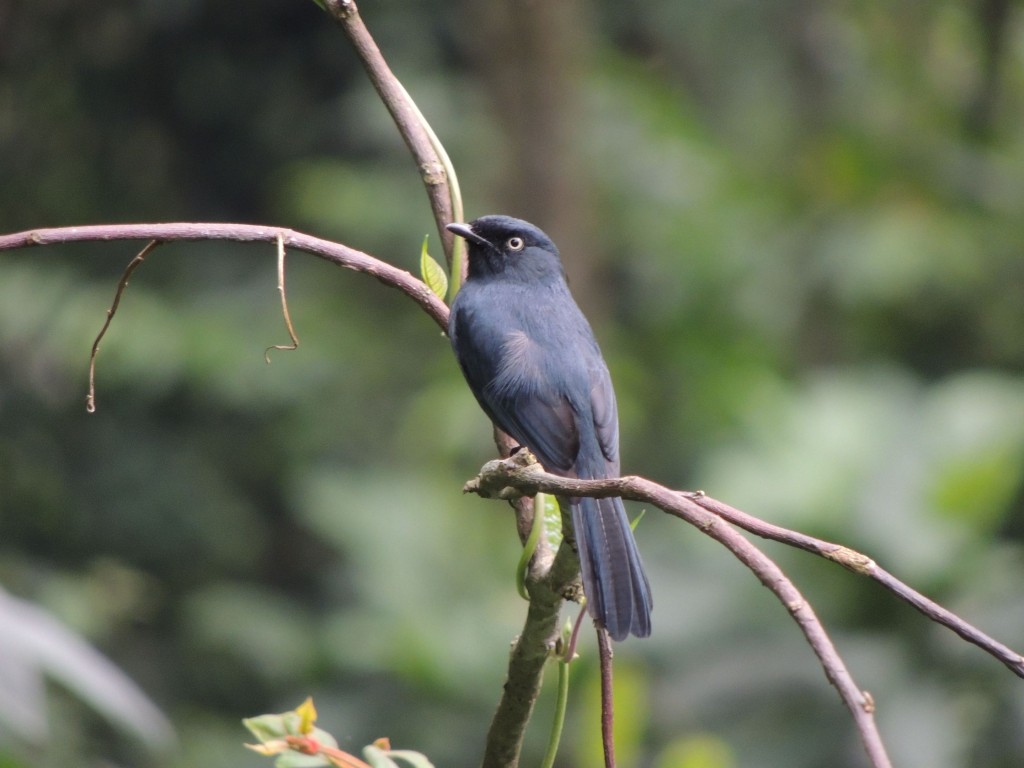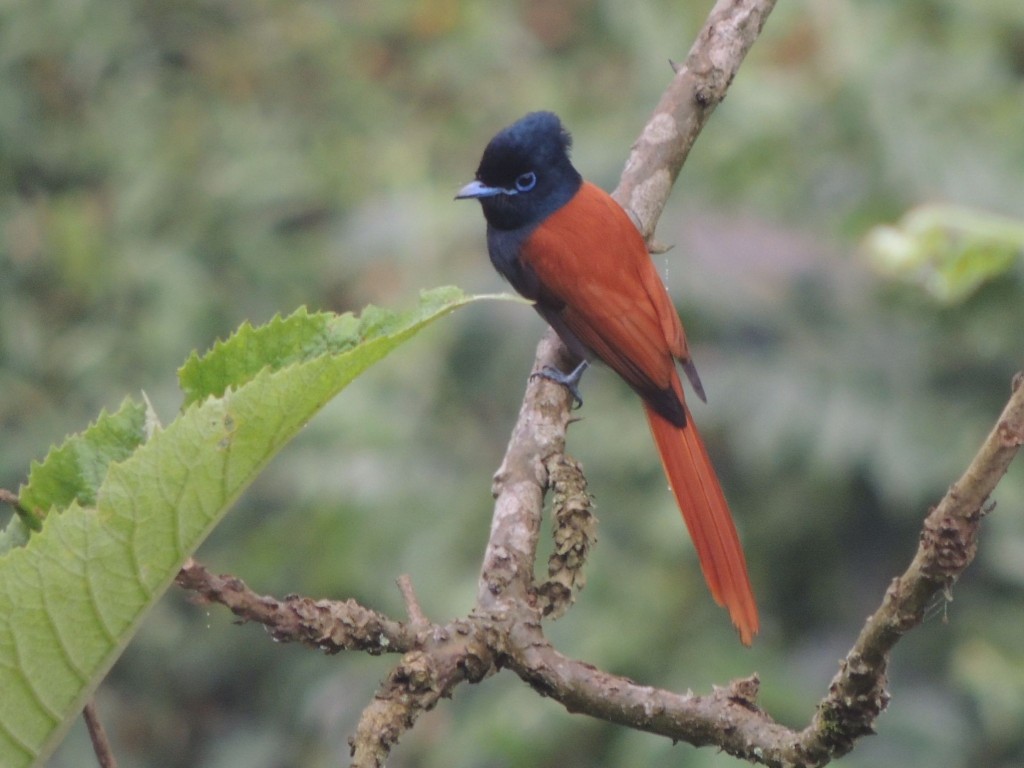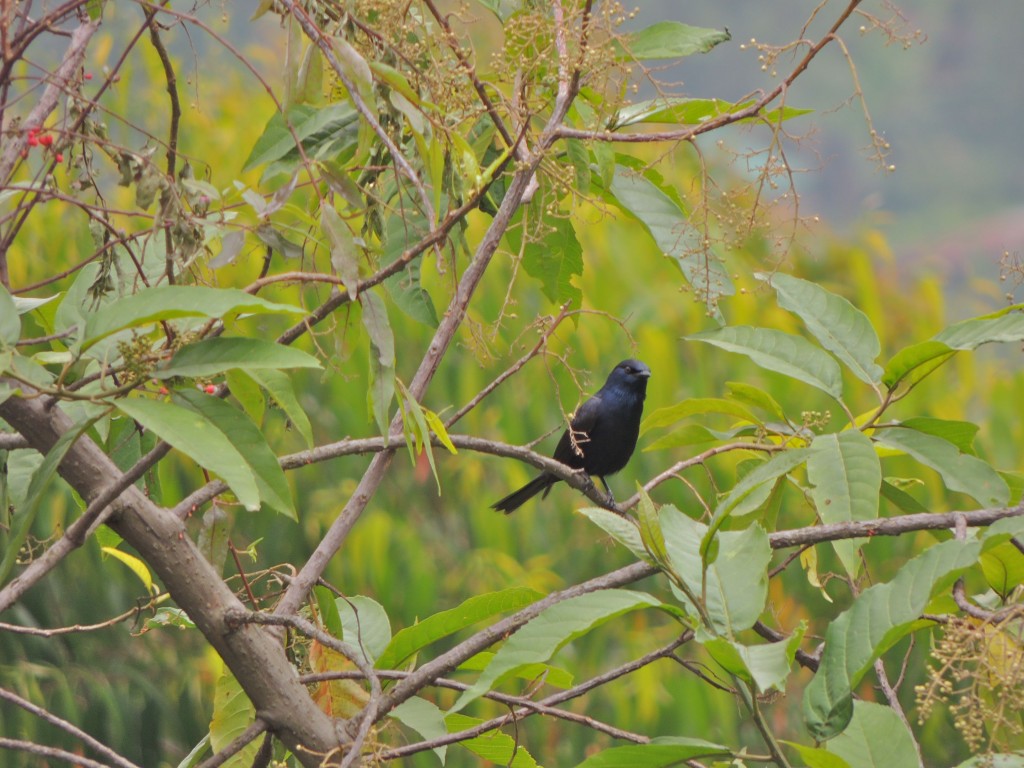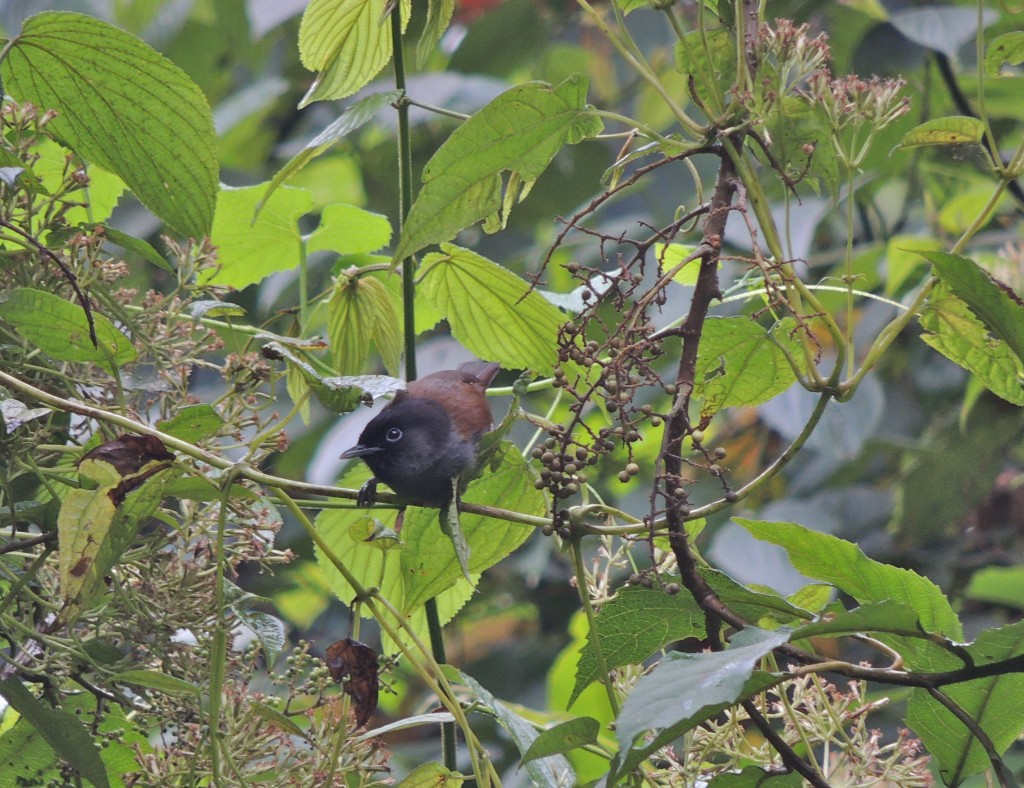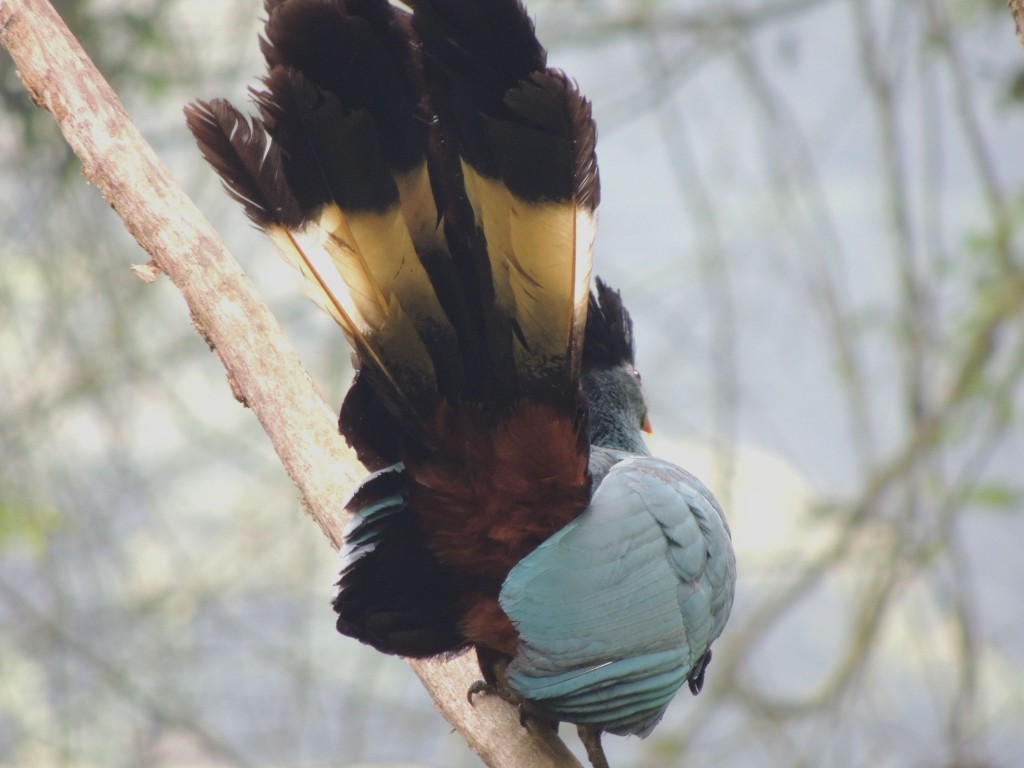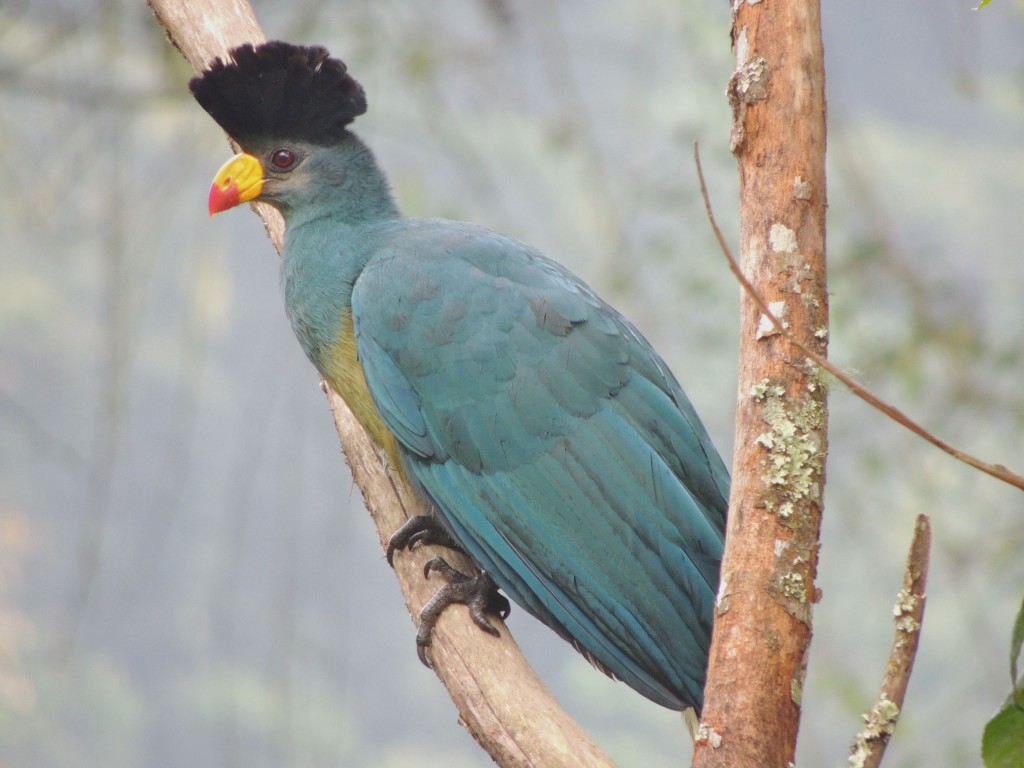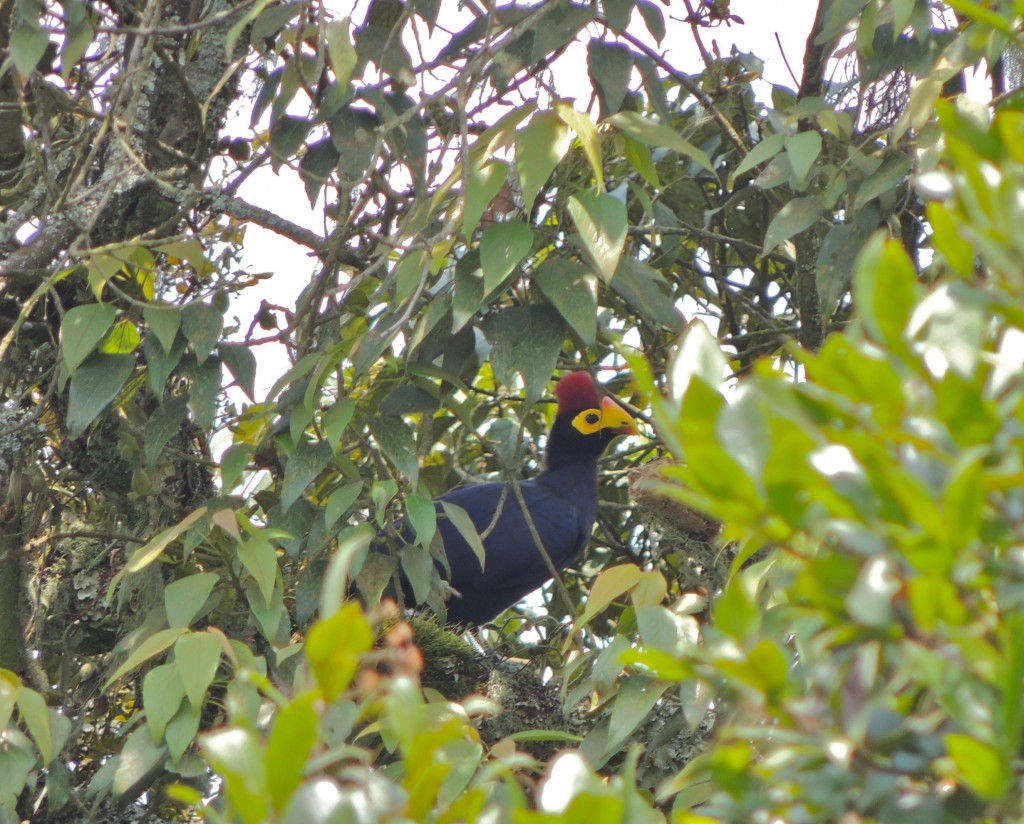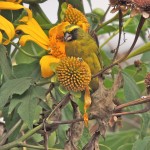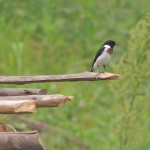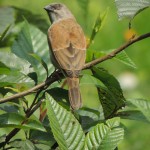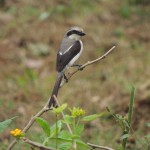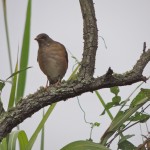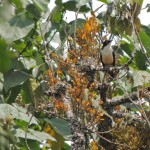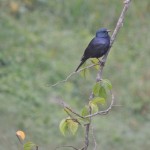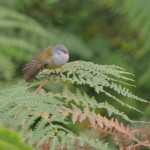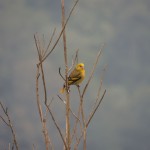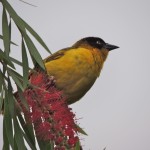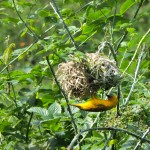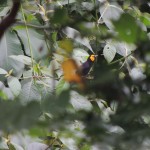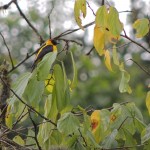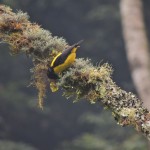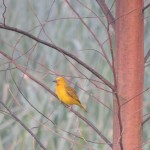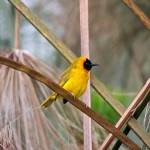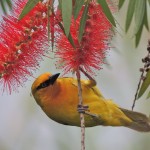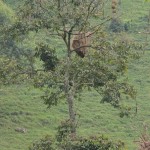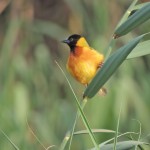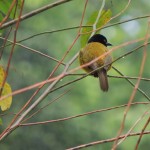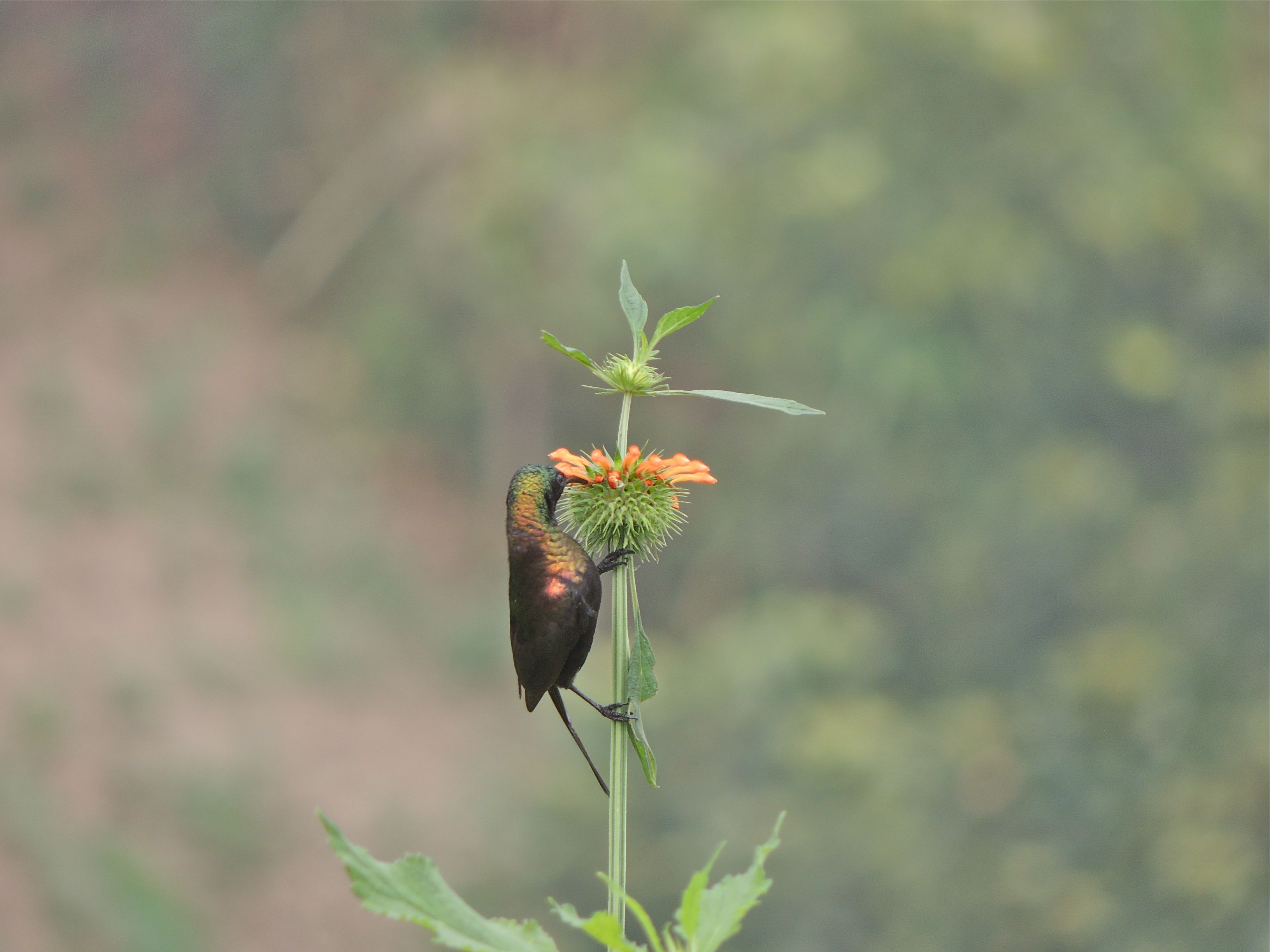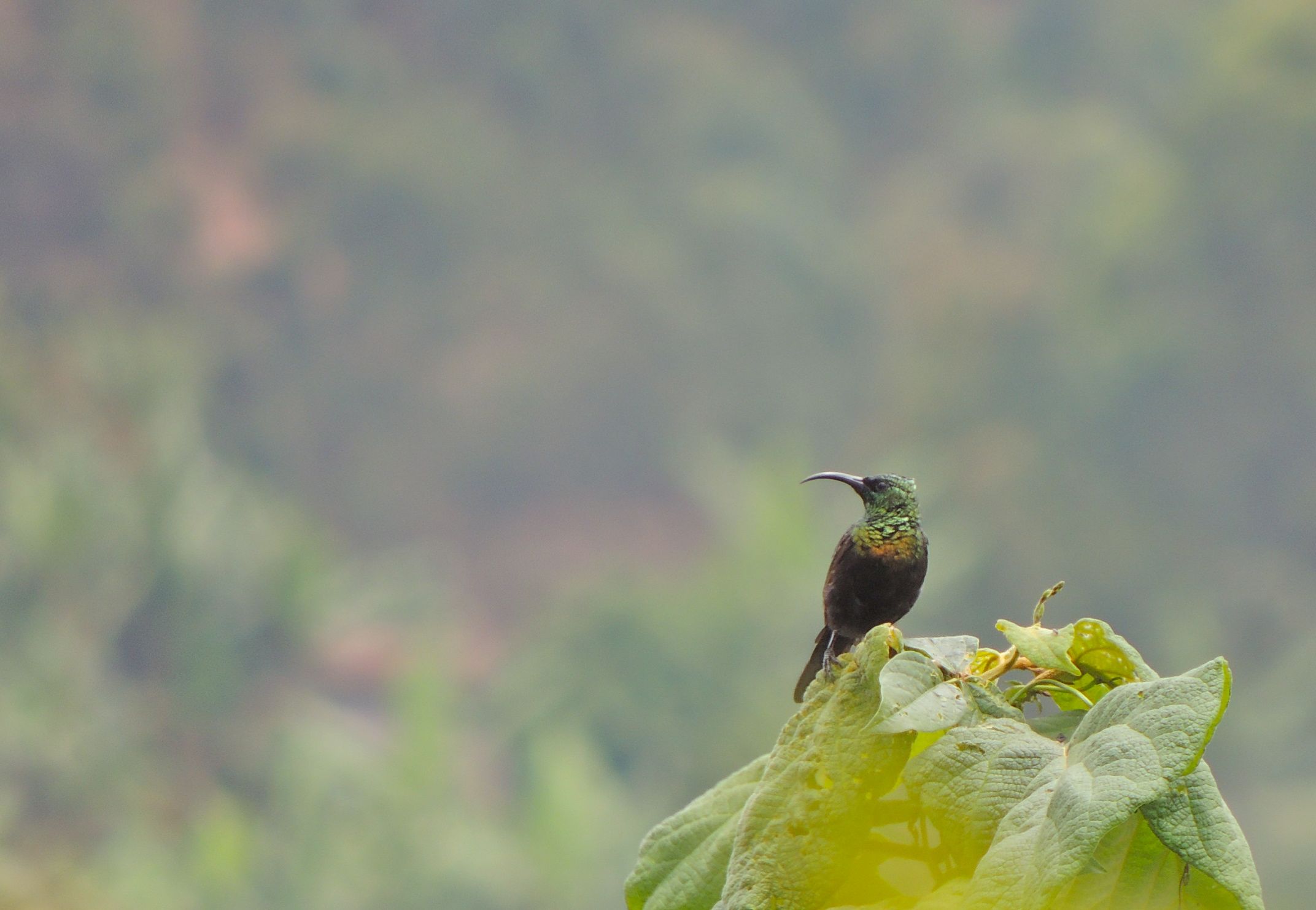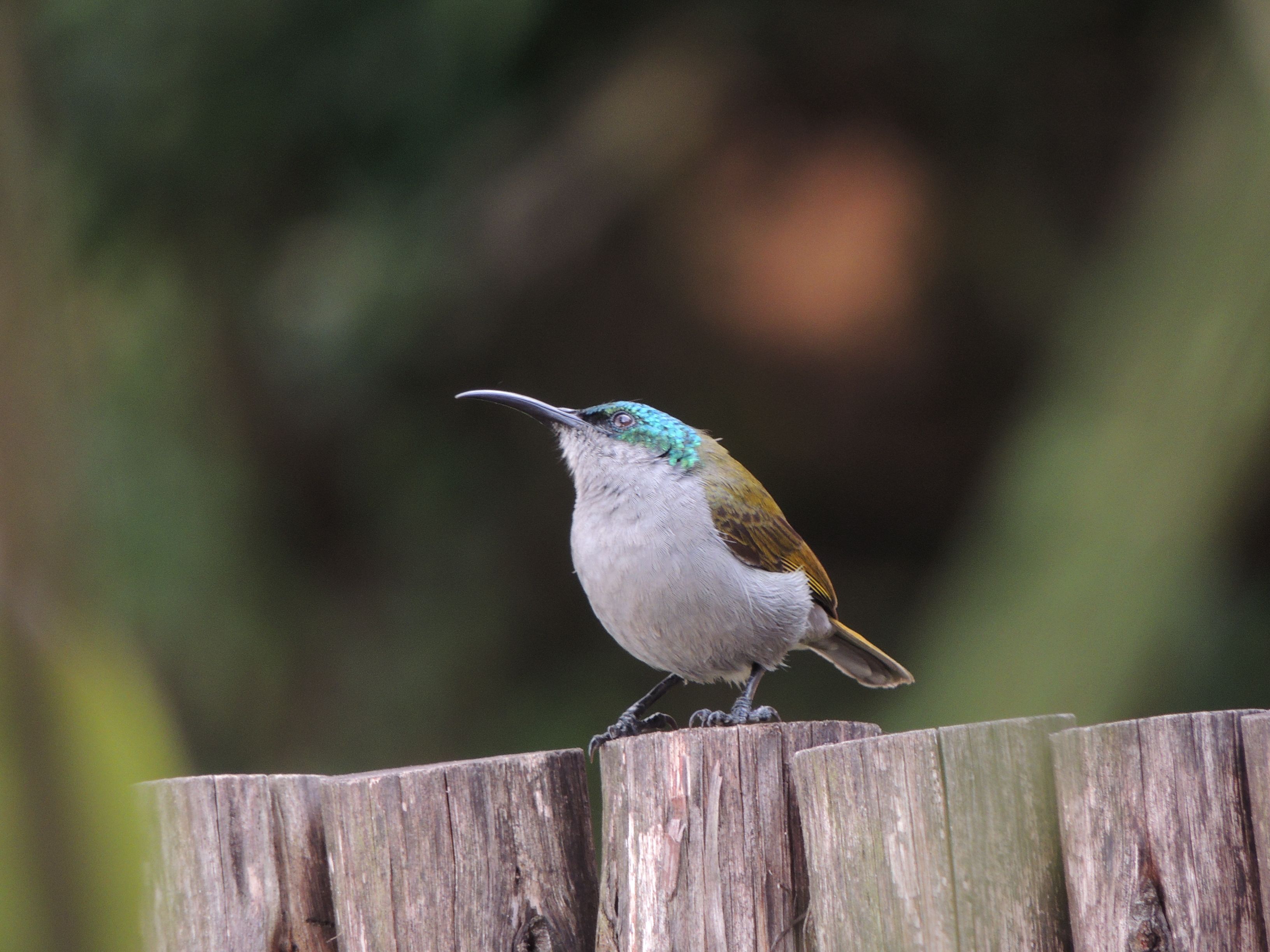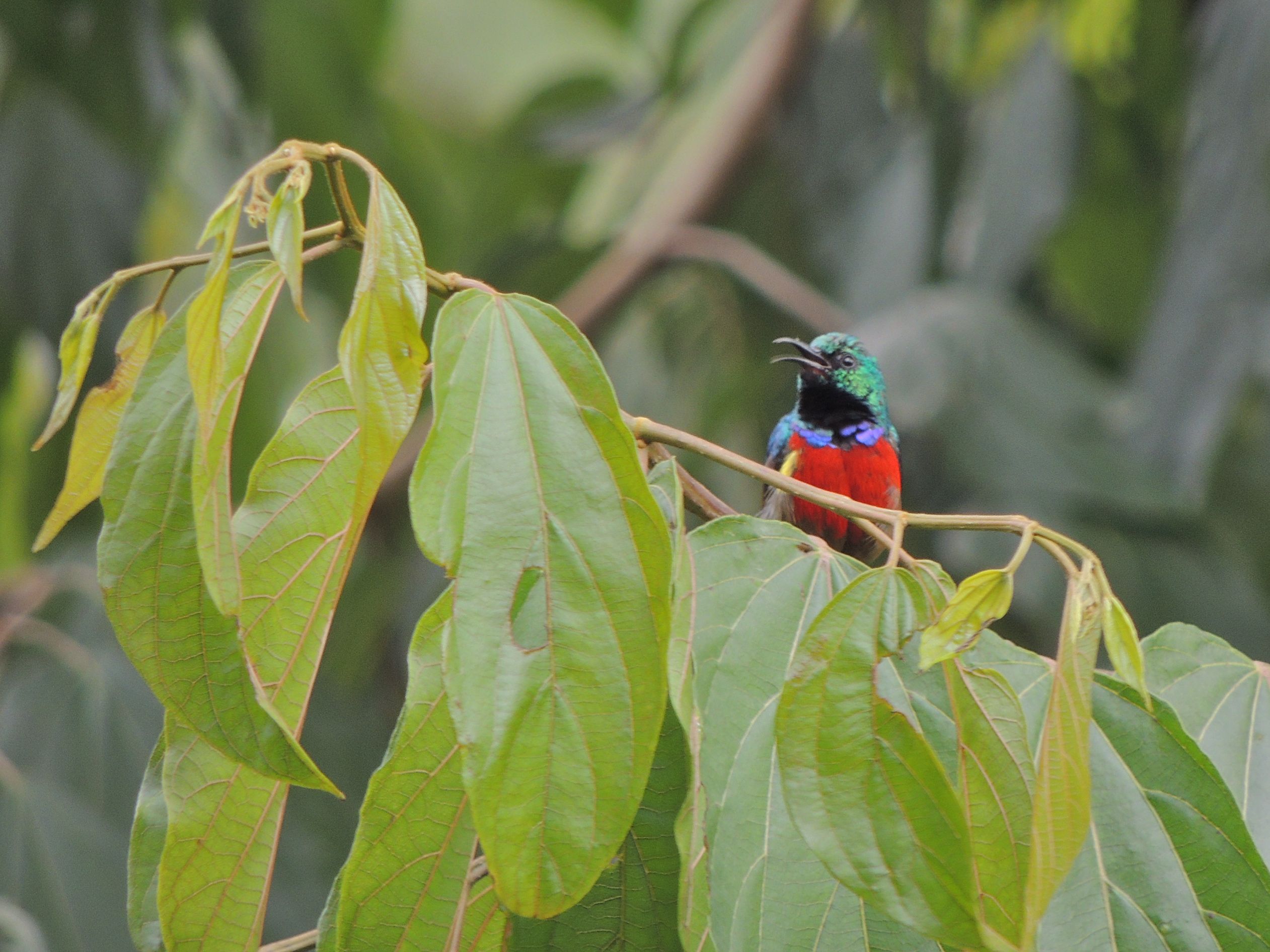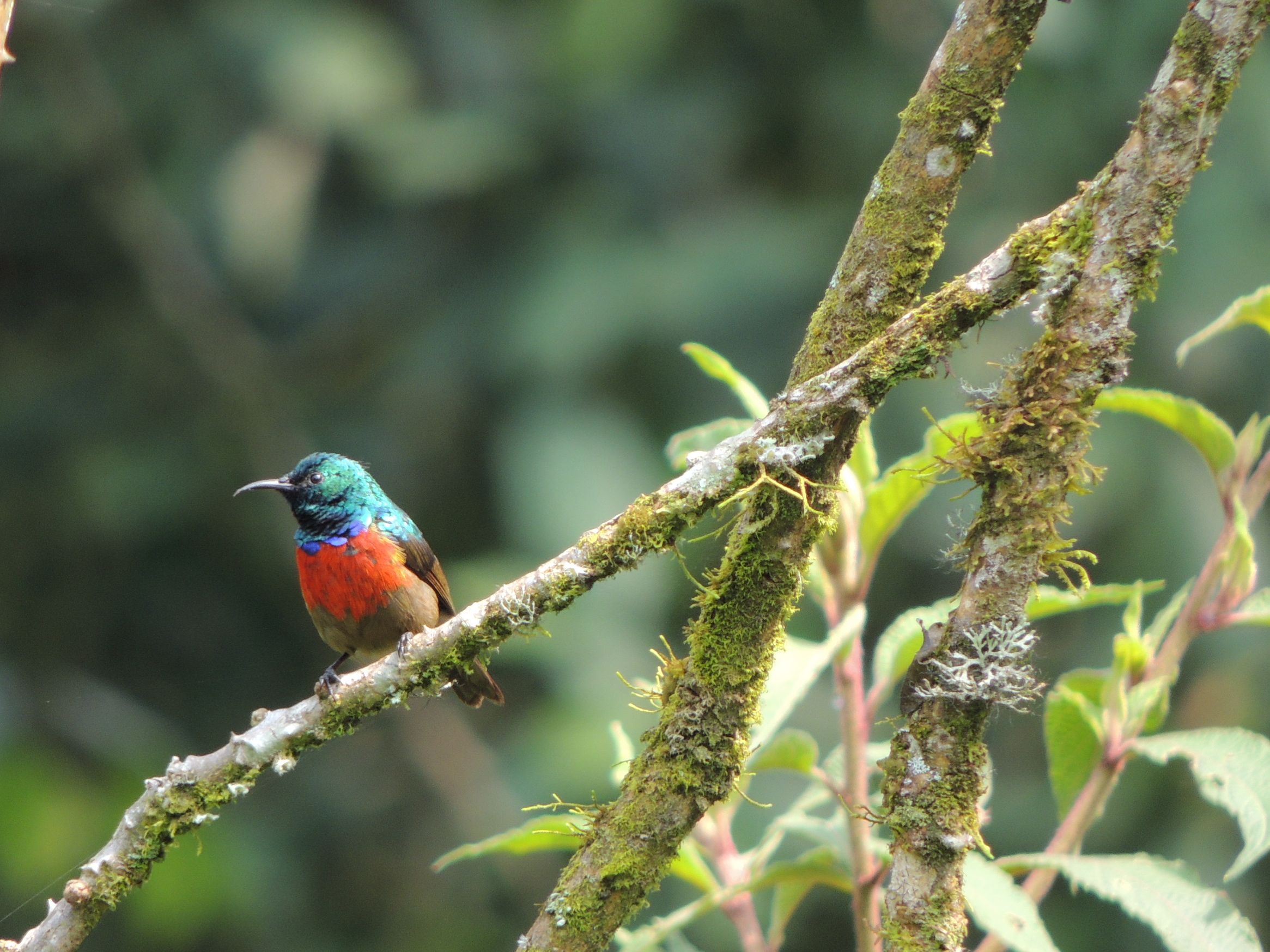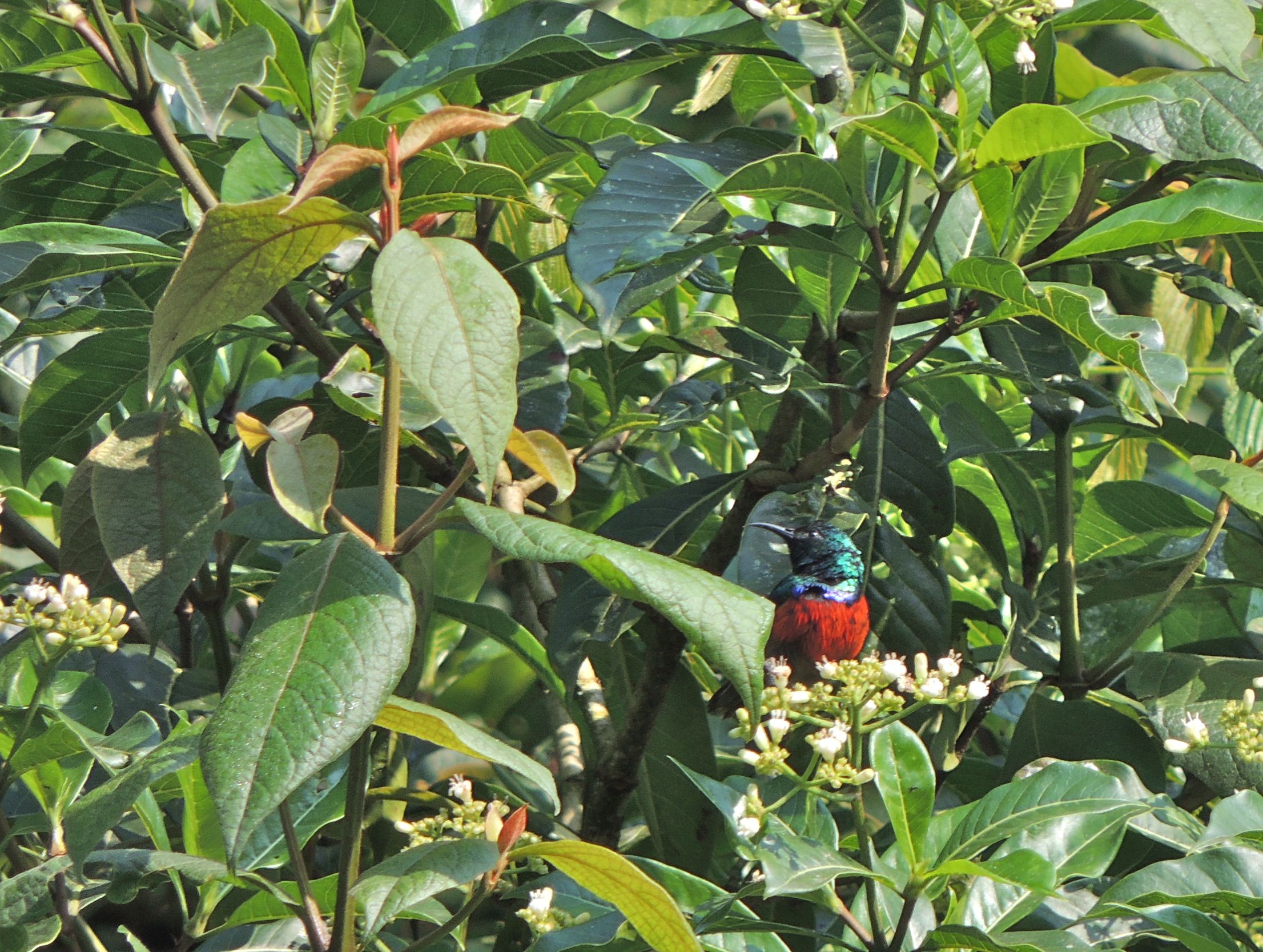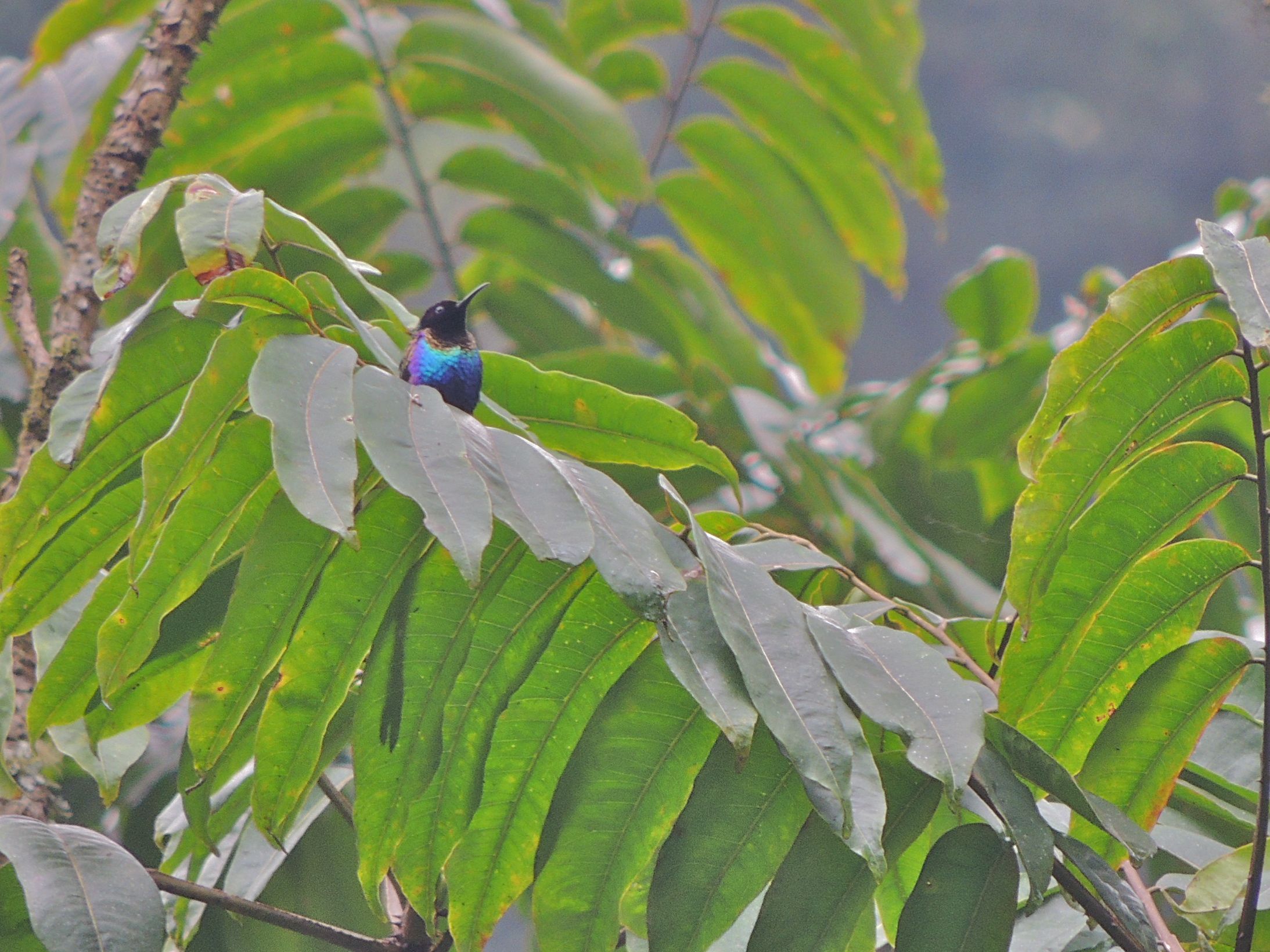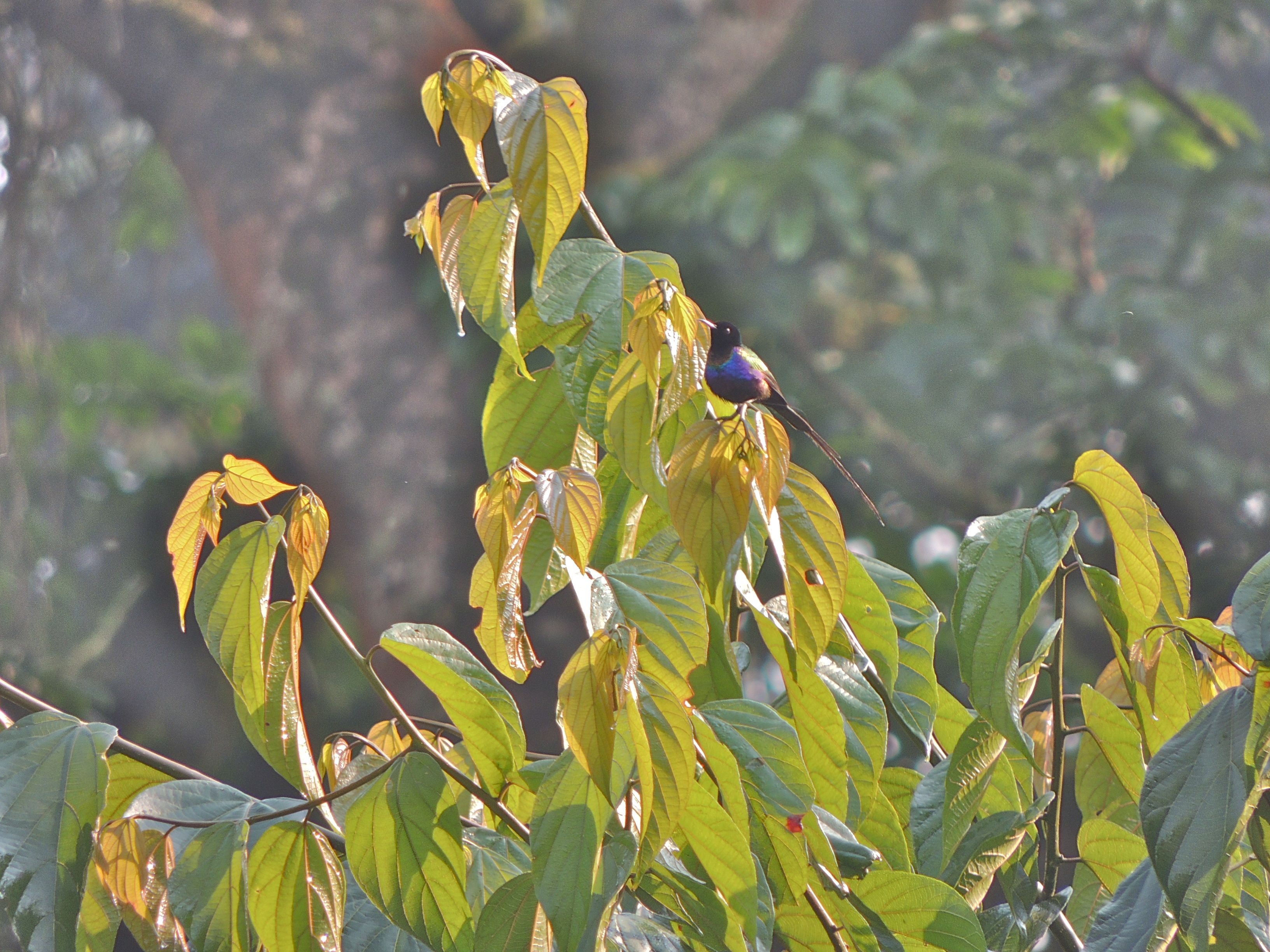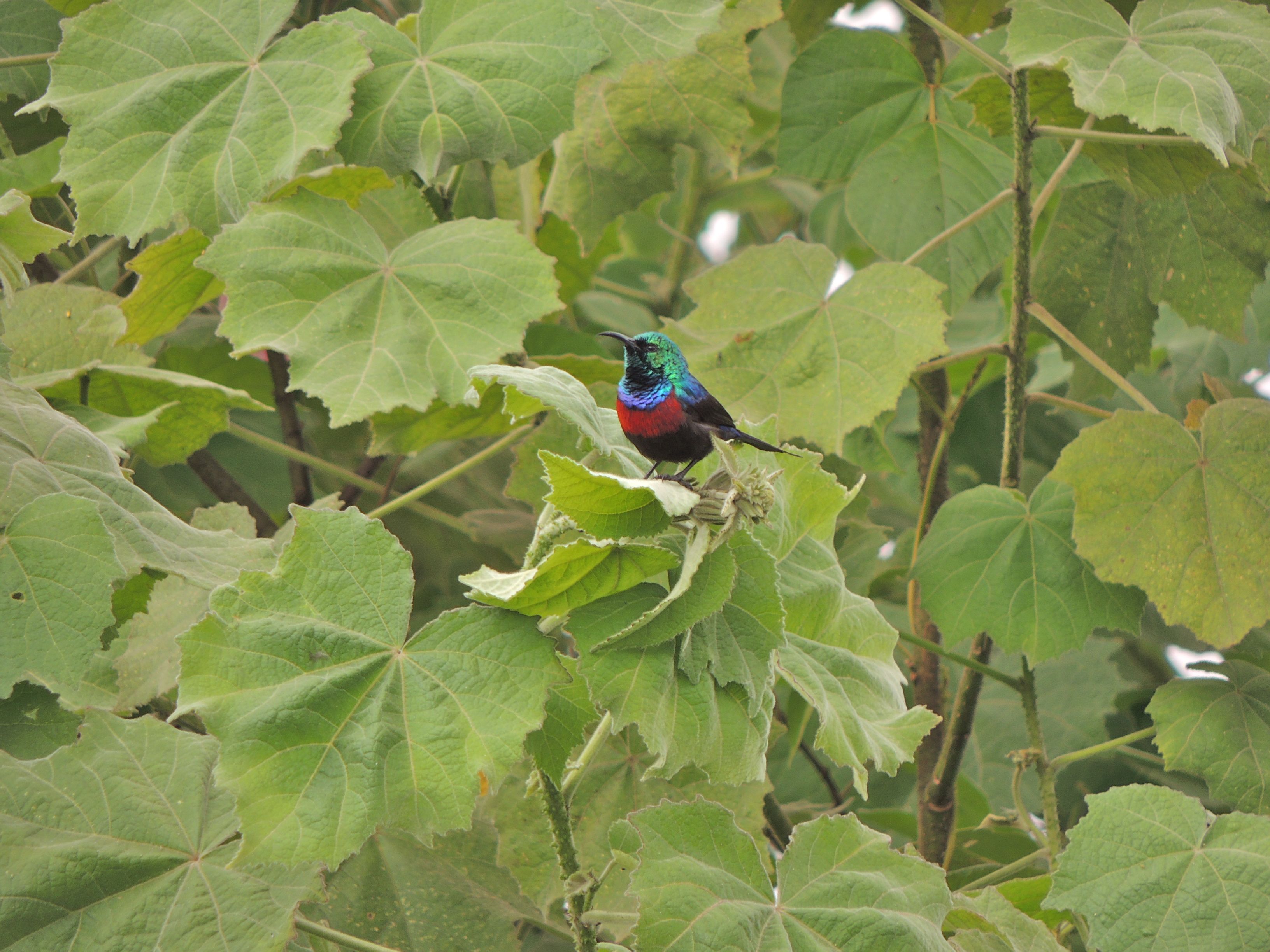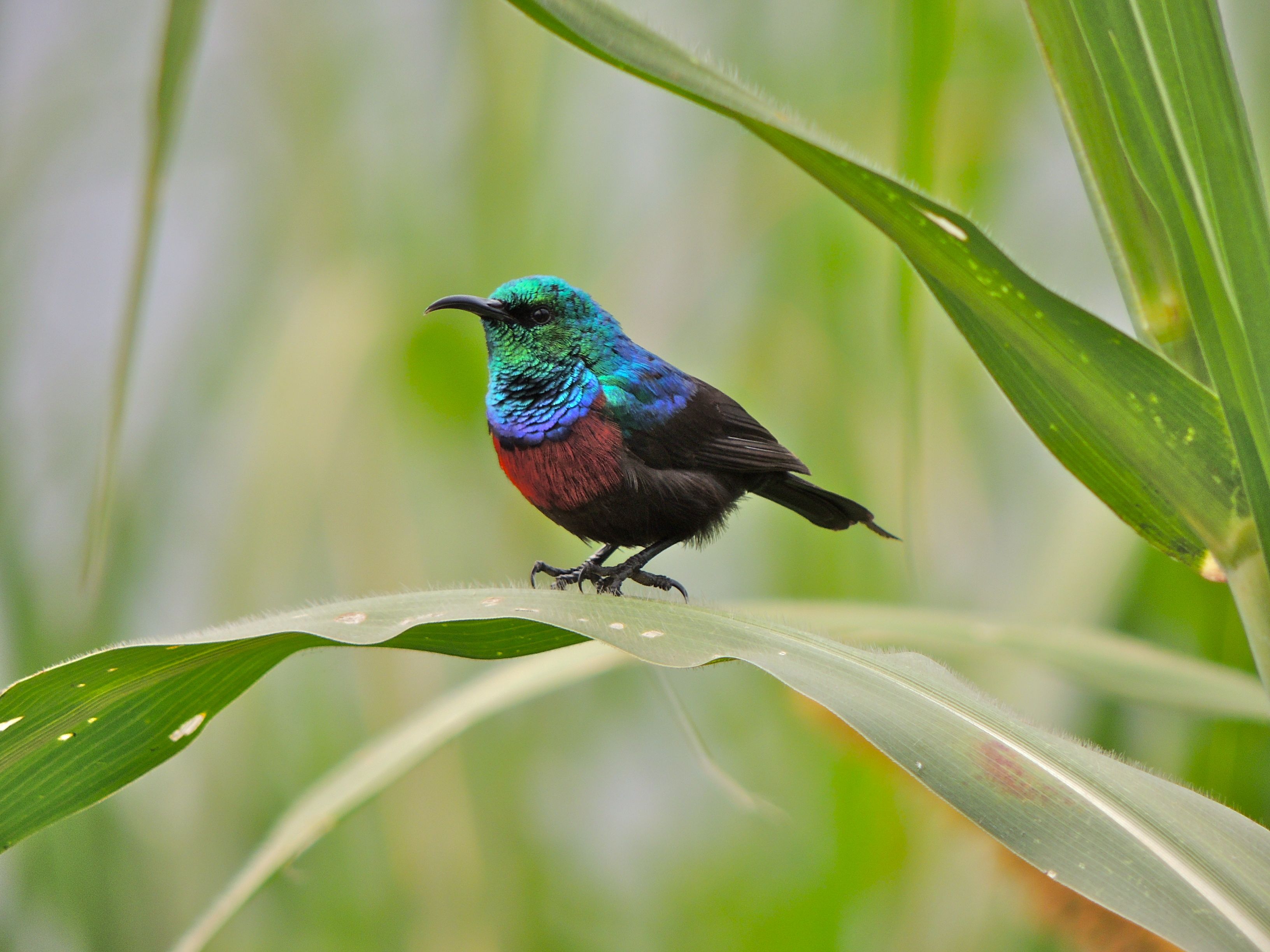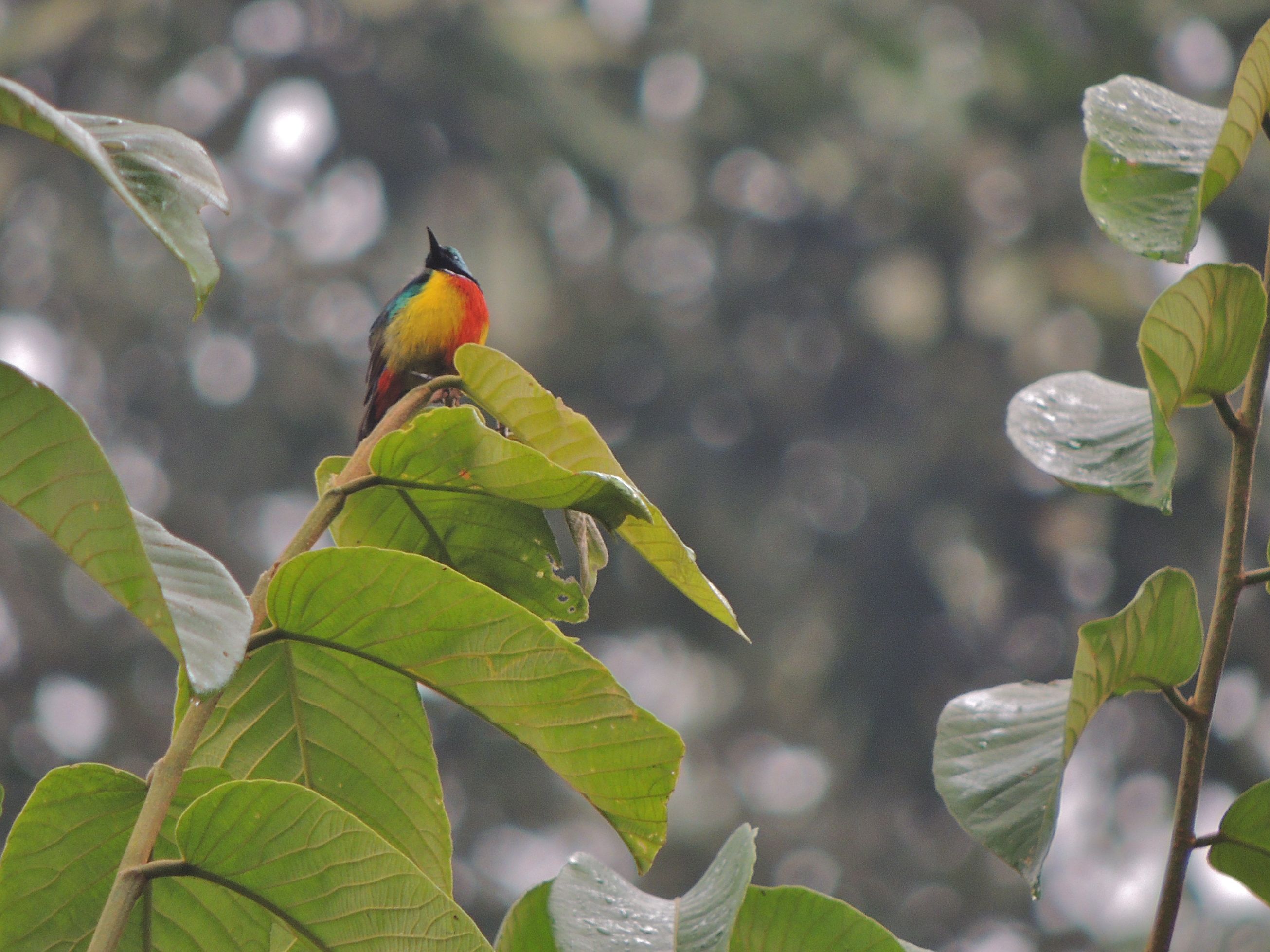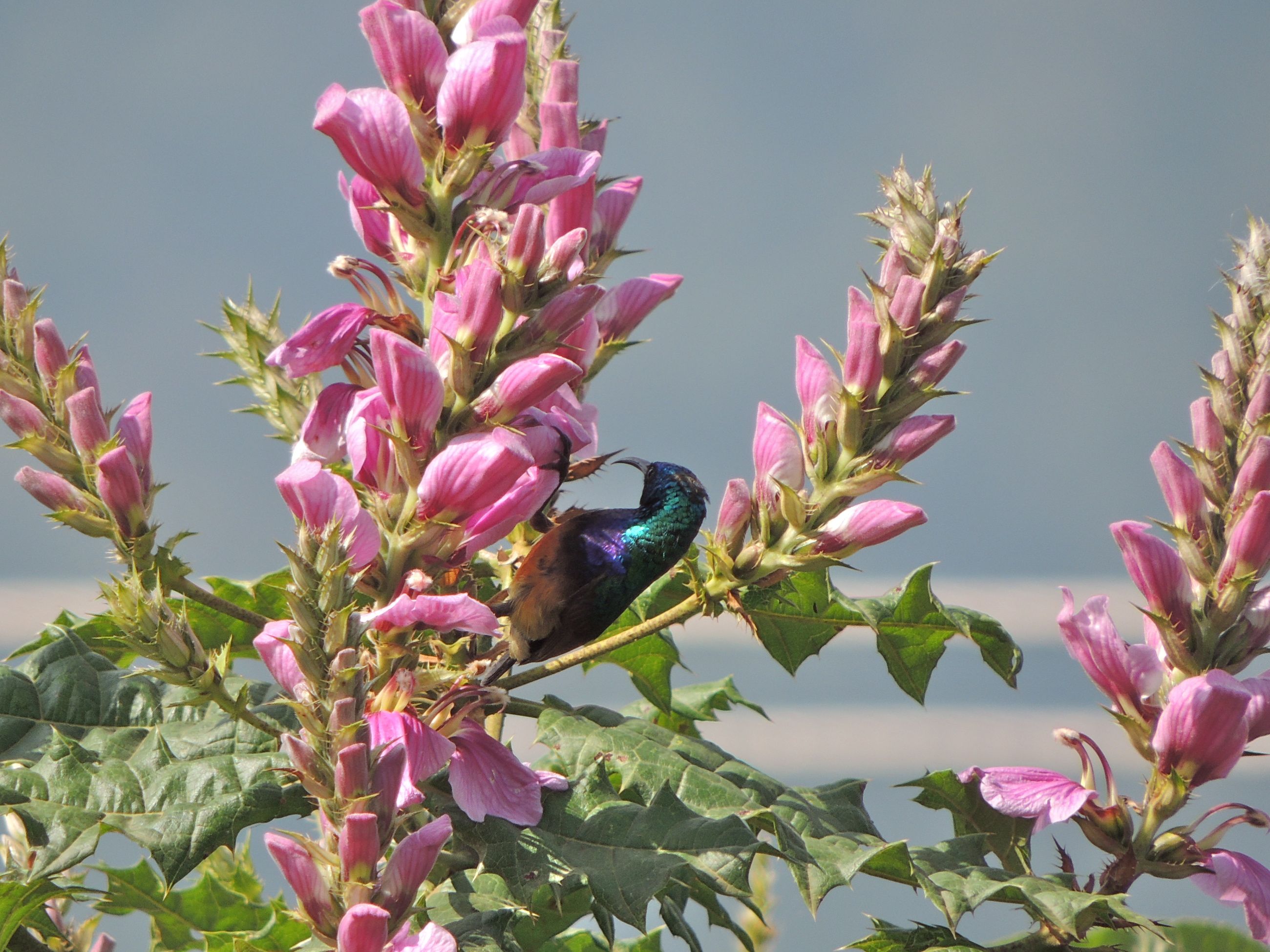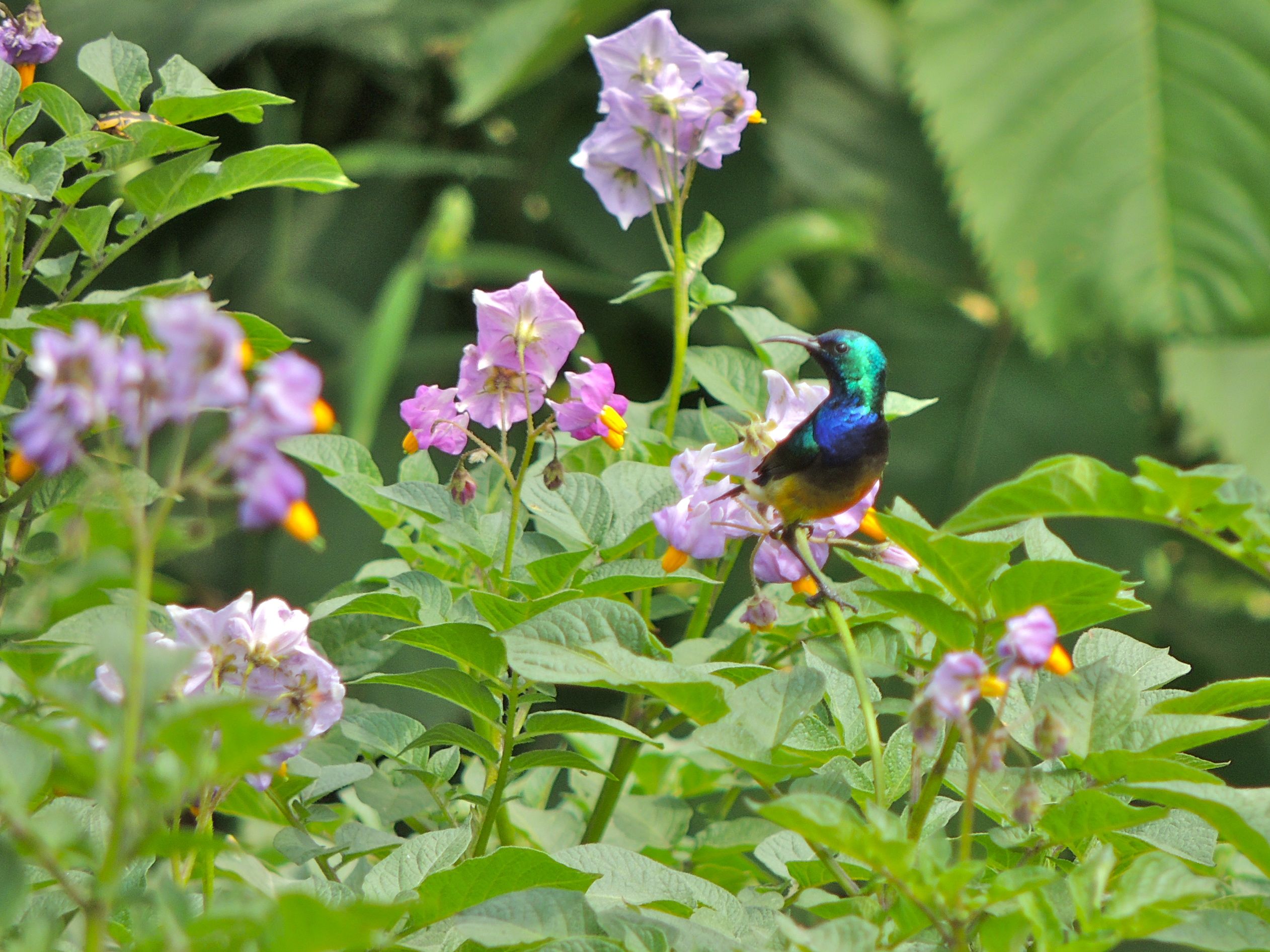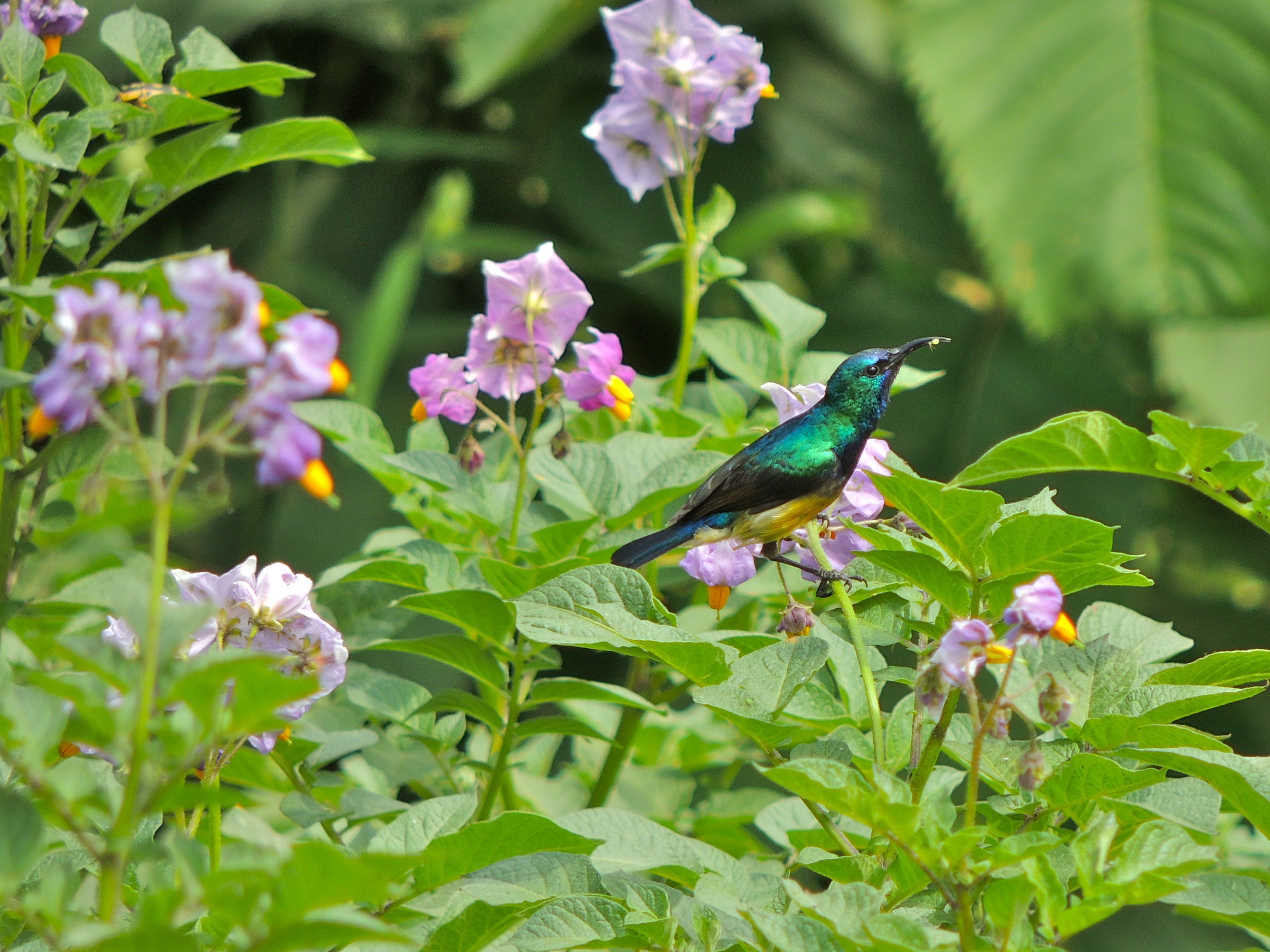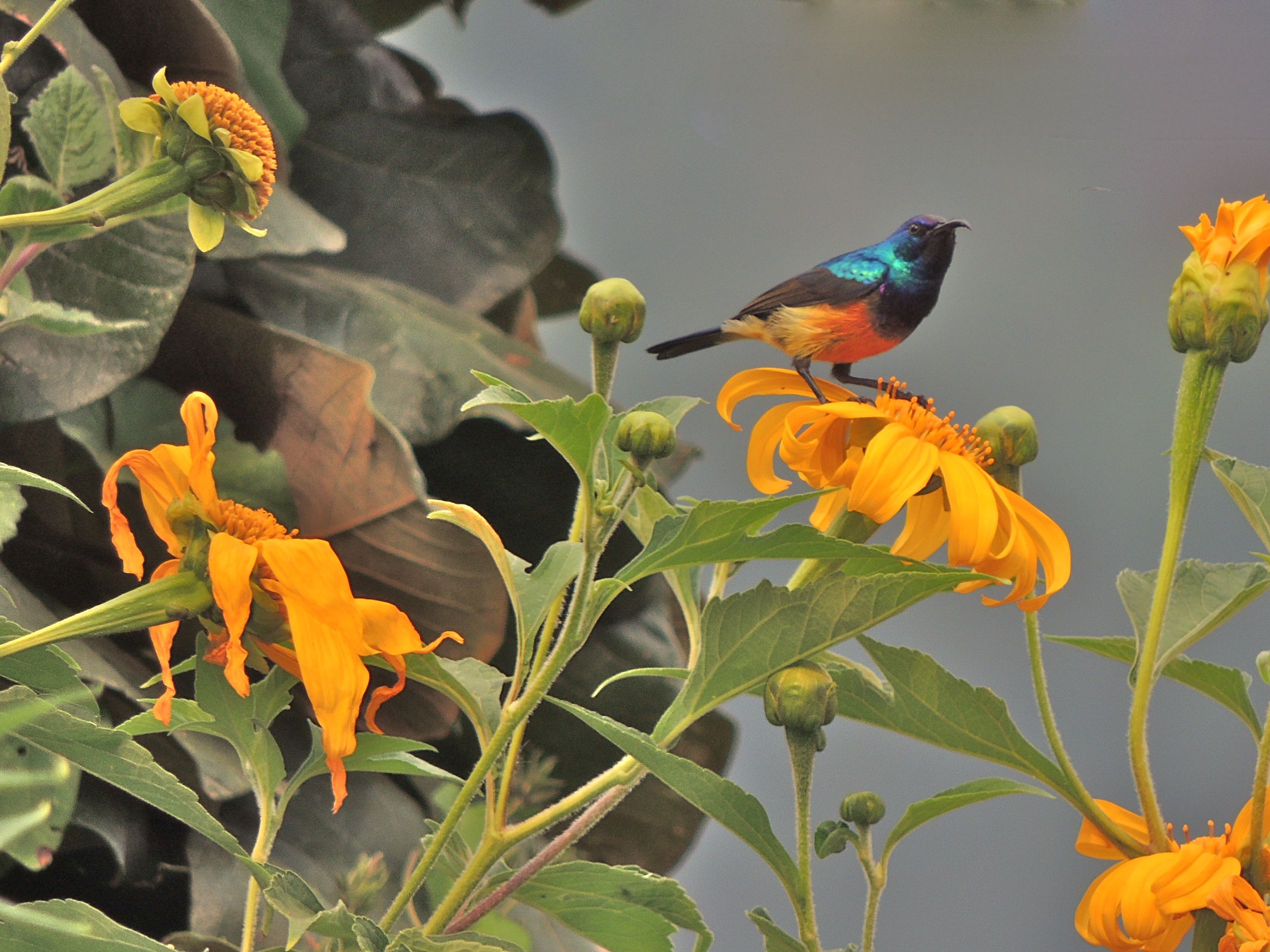For a summary of species highlights skip to the end of the narrative. (Click on any of the small images to enlarge. – Click on blue links for more information.)
The setting. When and where. This is a summary of my February 2016 birding experiences in and around Rubugari, a small community in the Kigezi Highlands of extreme southwest Uganda.
This area is within the Albertine Rift, a branch of the Great Rift Valley marked by folded mountains, lakes and volcanoes. It lies about 1,500 to 2,000 meters above sea level and is characterized by parallel ranges of steep hills that rise some 200- 500 metres to the (usually) open tops. There are lakes, small rivers, streams and marshes in the valley bottoms. At one time it was all cloaked in dense tropical rain forest.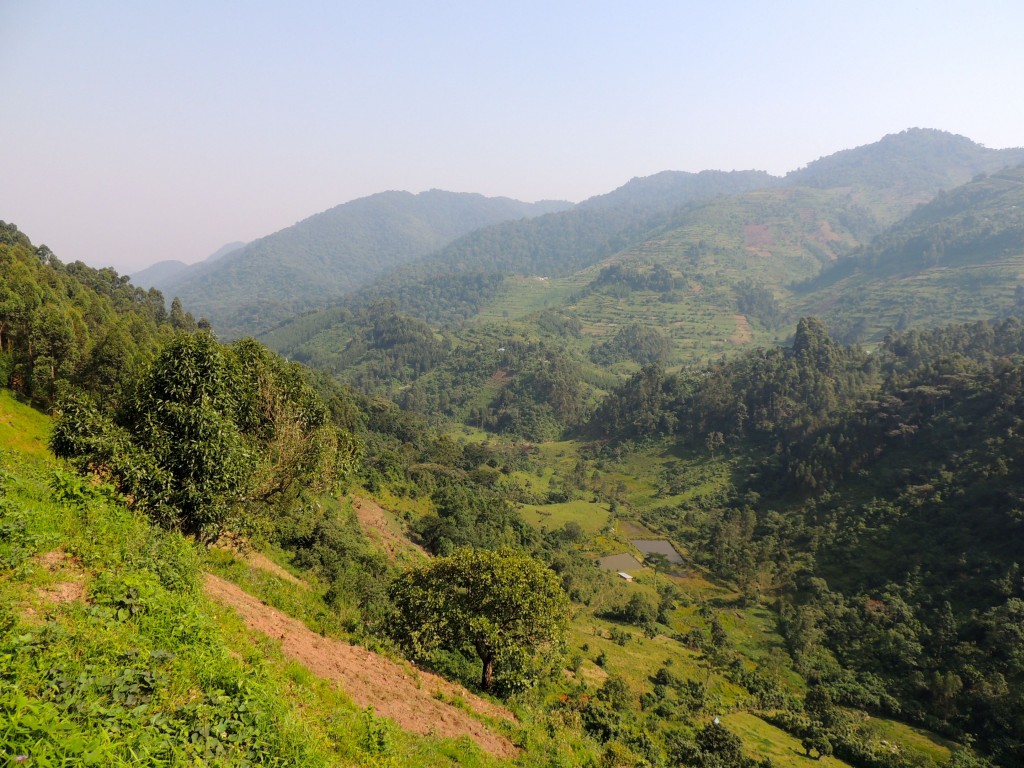
Today most of the land has been cleared and is either cultivated or grazed. In the above photograph, the unbroken expanse of forest in the distance is Bwindi Impenetrable Forest, a remnant of that virgin rain forest and protected as Bwindi Impenetrable Forest National Park. There is some good reading about Bwindi by clicking on this link or on Wikipedia. But briefly it is old, complex, and very biologically rich. It is home to several species of primates including Mountain Gorillas and is reputed to have over 350 species of birds.
Why I was there. I was engaged in some volunteer work to assess bird variety and populations with a view to promoting the area as a destination for birder-tourists. The birding is very good.
Local guides. Many of my new-found Rubugari friends were very competent birders and guides. Many times we would have missed a great bird had it not been for my guides’ skill in recognizing a song or call that eventually led to a sighting.
Birds of Bwindi Impenetrable Forest. Uganda Wildlife Authority (U.W.A) rigorously restricts access to Bwindi Impenetrable Forest National Park and few people, other than a limited daily quota of Gorilla-Trek tourists, enter the park. Permission for us to enter was not granted while I was there. But as birders know, you’ll usually see more birds at forest edges and around clearings than you will stuck in middle of it, it’s just easier. So we quite successfully sampled Bwindi by standing at the park’s clearly defined boundary.
The Albertine Rift is home to forty-two endemic species (species not found anywhere else in the world), twenty-three of them are found in Bwindi and we encountered nine of them by watching from the edge of park.
Many forest species stay low preferring the dense cover of undergrowth as they forage. We managed only fleeting looks at Red-faced Woodland Warbler, and Blue-mantled Crested Flycatcher. But others, including Yellow-eyed Black Flycatcher, Great Blue Turaco, Purple-breasted Sunbird and Regal Sunbird were reasonably easy to follow and enjoy. I recorded over fifty forest species in and around the edge of Bwindi (see more detail below).
Outside Bwindi almost everything changes. Although this part of Uganda is farmed extensively, the people live quite lightly on the land. They cultivate beans, maize, sorghum, yams, sweet potatoes and ‘Irish’ potatoes on small plots as well as raising some pigs, cows and chickens. Outside the forest, land use may be loosely classified as follows.
- Settlement areas with homes and garden patches.
- Cultivated hillside farmland.
- Grazing land.
- Non-native forest.
- Marshy valley bottoms.
I was asked what I thought was the most common bird and my unhesitating answer was Common Bulbul; you’ll find them anywhere any time. Close second was Chubb’s Cisticola a small, rather plain warbler with very interesting behaviour. I often saw them in small groups, whether these were family groups I’m not sure, but pairs sing a forceful, unvarying and interlocking duet.
In settlement areas there are many attractive, even elegant, species commonly seen as you go about your day. Pairs of White-browed Robin Chats, African Pied Wagtails, and Bronze Sunbirds were around my house all day. Cinnamon-chested Bee Eaters, White-tailed Blue Flycatchers and Pin-tailed Wydahs were common along roadsides. And like many places in the world, urbanization attracts sparrows and crows, in this case it was Grey-headed Sparrows and Pied Crows.
The cultivated hillsides naturally support species that find food where there is constant disturbance and crop rotation. Speckled Mousebird is common and considered a pest for nipping off bean flower buds. An African Pied Wagtail beside you as you work the field is considered a sign of a good harvest to come; a good thing since they seem to be everywhere. But its cousin, the equally common Cape Wagtail, somehow doesn’t come with the same promise.
Grazing land may be on hillsides or in valley-bottom. Either way, it’s where we could rely on seeing one or other of the ‘Lanius’ shrike species a Mackinnons Fiscal or less often a Common Fiscal. Both are quite aggressive and spend a lot of energy harassing smaller birds. Grey-crowned Cranes, usually in pairs, stalk around open fields and you can usually see Augur Buzzards either wheeling overhead or prominently perched digesting their latest catch.
Valley bottoms were always productive, it is land that is usually not cultivated and perhaps never has been. There was plenty of evidence of grazing by goats and cattle and, close to Bwindi, visits by Mountain Gorillas and Duiker (a small deer). Some valley areas held wide expanses of rushes, sedges and papyrus; great habitat for several weaver species including Holub’s Golden Weaver. And on one occasion we heard one of East Africa’s secretive heard-but-rarely-seen Rail species, a Red-chested Flufftail.
Appendix – A list of species could become tedious reading. Here is a selection of highlights sorted informally by habitat or similarity.
BWINDI FOREST BIRDS. Although we were not able to enter Bwindi Impenetrable Forest National Park the following is a partial list of birds that we saw that were associated with the dense virgin forest habitat.
Nine Albertine Rift endemics: Blue-headed Sunbird, Purple-breasted Sunbird, Regal Sunbird, Collared Apalis, Dusky Crimsonwing, Red-faced Woodland Warbler, Rwenzori Batis, Strange Weaver and Yellow-eyed Black Flycatcher.
I was also excited to see: Emerald Cuckoo, Klaas’s Cuckoo, Montane Oriole, Bocage’s Bush Shrike, Ludher’s Bush Shrike, Yellow-whiskered Greenbul, African Green Pigeon, Black-faced Rufous Warbler, Grey-backed Cameroptera and White-chinned Prinia.
Among flycatchers we only glimpsed Blue-mantled Crested Flycatcher, but Yellow-eyed Black Flycatcher was more sedentary. Just outside Bwindi we were pleased with a Southern Black Flycatcher and a pair of Black and White Shrike Flycatchers. And easily seen in or out of Bwindi were two common species, African Dusky Flycatcher and African Paradise Flycatcher.
Bwindi has many spectacular birds. On a couple of trips we saw Ross’s Turaco and Great Blue Turaco, both are large (chicken-size) and rather ponderous but breathtakingly showy; when you see them you can usually enjoy them for a while. Bwindi has some beautiful sunbirds too: Apart from the Albertine Rift endemics listed above we also saw Collared, Northern Double Collared and Green-headed Sunbirds .
OUTSIDE BWINDI FOREST. Around settlements – Baglafect Weaver, Olive Thrush, White-browed Robin Chat, Speckled Mousebird, African Citril, White-tailed Blue Flycatcher, White-eyed Slaty Flycatcher and Grey-headed Sparrow are all very common. A few sunbirds (see below) add an exuberant splash of colour.
Hillsides and tops – support Pied Crow, White-naped Raven, Yellow-crowned Canary, Sharpe’s Starling, Stuhlmann’s Starling, White-eyed Slaty Flycatcher, White-tailed Blue Flycatcher, Pin-tailed Wydah, Common Bulbul, Streaky Seedeater, Doherty’s Bush Shrike, and pairs of Grey-crowned Cranes.
Grazing land – is good for: Mackinnons Fiscal, Speckled Mousebird, Pin-tailed Wydah, Yellow-bellied Waxbill, Black-crowned Waxbill, Chubb’s Cisticola, Cape Wagtail, Pied Wagtail, White-tailed Blue Flycatcher and Common Stonechat.
Wet valley bottoms – are good places to look for Holub’s Golden Weaver, Hamerkop, Fan-tailed Widowbird, Yellow Bishop, Common Stonechat, Malachite Kingfisher, Yellow-whiskered Greenbul, Blue-headed Coucal and on one occasion we heard a Red-chested Flufftail.
BIRDS OF PREY. Augur Buzzard is probably the most common followed closely by Black Kites. Long-crested Eagle is supposedly common but I only saw three in a month. On nearby Lake Mutanda I watched a Great Sparrowhawk mercilessly chasing other birds. A young Ayer’s Hawk-Eagle was a surprise visitor to a pig shelter, it watched the pigs for a while but eventually decided they were far too big to carry off. A single Palm Nut Vulture was an unexpected surprise.
WEAVERS. A fascinating, usually conspicuous but challenging family occupying varied habitats. A few species of weavers prefer thick forests and we found, Black-billed Weaver, Brown-capped Weaver and Strange Weaver in or close to Bwindi Impenetrable Forest. Lake edges and marshy valley bottoms attracted Holub’s Golden, Spectacled, Yellow-backed and Slender-billed Weavers. Baglafecht Weavers seemed to be happy almost anywhere and we could often find Black-headed Weavers colonies in open country with tree-top nests close to large wasps’ nest.
Identifying high-flying or fast-moving birds always leaves you wondering. Swallows and martins on the wing are really tough especially since they often gather in mixed-species flocks. We felt secure identifying Barn Swallow, Red-rumped Swallow, Rufous-chested Swallow, Angola Swallow, Black Saw-wing, Common House Martin and Rock Martin. Swifts are even trickier and we saw several wheeling around, probably African Black Swift.
Saving perhaps the best for last- SUNBIRDS deserve special mention, they are so gorgeous. I saw: Blue-headed*,Purple-breasted*, Regal*, Green-headed, Bronze, Collared, Northern Double collared, Scarlet-chested, Red-chested, Variable and Tiny Sunbirds. The first three with an asterisk are Albertine Rift endemics. Here are some of my favourite photos. (Click on any image to enlarge)
